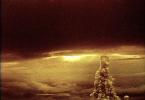Blew up near Nagasaki. Death and destruction accompanied by these explosions were unprecedented. Fear and horror engulfed the entire Japanese population, forcing them to surrender in less than a month.
However, after the end of the Second World War, atomic weapons did not fade into the background. The outbreak of the cold war became a huge psychological factor of pressure between the USSR and the USA. Both sides invested heavily in the development and creation of new nuclear. Thus, on our planet for 50 years, accumulated several thousand atomic shells. This is quite enough to destroy all living things several times. For this reason, in the late 1990s, the first disarmament treaty was signed between the United States and Russia in order to reduce the danger of a global catastrophe. In spite of this, currently 9 countries possess nuclear weapons, putting their defenses on a different level. In this article, we will look at how a nuclear weapon gained its destructive power and how an atomic one works.
In order to understand the full power of atomic bombs, it is necessary to understand the concept of radioactivity. As is known, the smallest structural unit of matter, of which the whole world is composed around us, is an atom. An atom in turn consists of a nucleus and revolving around it. The nucleus consists of neutrons and protons. Electrons have a negative charge, and protons are positive. Neutrons, as their name implies, are neutral. Usually the number of neutrons and protons is equal to the number of electrons in a single atom. However, under the action of external forces, the number of particles in the atoms of a substance can change.
We are only interested in the option when the number of neutrons changes, and an isotope of matter is formed. Some isotopes of matter are stable and occur in nature, and some are unstable and tend to decay. For example, carbon has 6 neutrons. Also, there is a carbon isotope with 7 neutrons - a fairly stable element found in nature. A carbon isotope with 8 neutrons is an unstable element and tends to disintegrate. This is radioactive decay. At the same time, unstable nuclei emit rays of three types:
1. Alpha rays are harmless enough in the form of a stream of alpha particles that can be stopped using a thin sheet of paper and it cannot cause harm
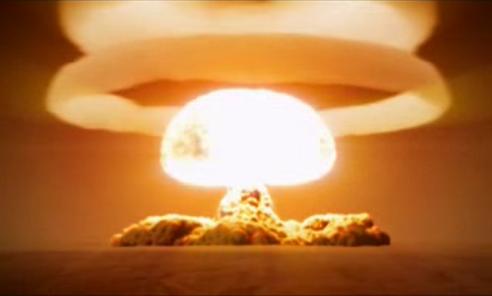 Even if living organisms were able to transfer the first two, the radiation wave causes a very transient radiation sickness, which kills in a matter of minutes. Such a defeat is possible within a radius of several hundred meters from the explosion. Up to several kilometers from the explosion, radiation sickness will kill a person in a few hours or days. Those who were outside the immediate explosion may also receive a dose of radiation by eating foods and breathing from the infected area. And the radiation does not evaporate instantly. It accumulates in the environment and can poison living organisms for many decades after the explosion.
Even if living organisms were able to transfer the first two, the radiation wave causes a very transient radiation sickness, which kills in a matter of minutes. Such a defeat is possible within a radius of several hundred meters from the explosion. Up to several kilometers from the explosion, radiation sickness will kill a person in a few hours or days. Those who were outside the immediate explosion may also receive a dose of radiation by eating foods and breathing from the infected area. And the radiation does not evaporate instantly. It accumulates in the environment and can poison living organisms for many decades after the explosion.
The harm from nuclear weapons is too dangerous to use in any conditions. The civilian population inevitably suffers from it and irreparable damage is caused to nature. Therefore, the main use of nuclear bombs in our time is deterrence from attack. Even tests of nuclear weapons are currently banned on most of our planet.
It is one of the most amazing, mysterious and scary processes. The principle of operation of nuclear weapons is based on a chain reaction. This is a process, the very course of which initiates its continuation. The principle of the hydrogen bomb is based on synthesis.
Atomic bomb
The nuclei of some isotopes of radioactive elements (plutonium, californium, uranium and others) are able to decay, while capturing a neutron. After that, two or three more neutrons are released. The destruction of the nucleus of one atom under ideal conditions can lead to the disintegration of two or three more, which, in turn, can initiate other atoms. And so on. There is an avalanche-like process of destruction of an increasing number of nuclei with the release of a huge amount of atomic bond breaking energy. With the explosion, huge energies are released in an ultra-small amount of time. It happens at one point. Therefore, the atomic bomb explosion is so powerful and destructive.
 To initiate the start of a chain reaction, it is necessary that the amount of radioactive substance exceeds the critical mass. Obviously, you need to take several parts of uranium or plutonium and combine into one. However, to cause an atomic bomb explosion, this is not enough, because the reaction will stop before a sufficient amount of energy is released, or the process will proceed slowly. In order to achieve success, it is necessary not only to exceed the critical mass of the substance, but to do it in an extremely small period of time. It is best to use several critical masses. This is achieved through the use of other And alternate fast and slow explosives.
To initiate the start of a chain reaction, it is necessary that the amount of radioactive substance exceeds the critical mass. Obviously, you need to take several parts of uranium or plutonium and combine into one. However, to cause an atomic bomb explosion, this is not enough, because the reaction will stop before a sufficient amount of energy is released, or the process will proceed slowly. In order to achieve success, it is necessary not only to exceed the critical mass of the substance, but to do it in an extremely small period of time. It is best to use several critical masses. This is achieved through the use of other And alternate fast and slow explosives.
The first nuclear test was conducted in July 1945 in the United States near the town of Almogordo. In August of the same year, the Americans used these weapons against Hiroshima and Nagasaki. The explosion of the atomic bomb in the city led to the terrible destruction and death of most of the population. In the USSR, atomic weapons were created and tested in 1949.
H-bomb
It is a weapon with a very large destructive power. Its principle of operation is based on which is the synthesis of lighter atoms of hydrogen from heavy helium nuclei. When this occurs, the release of a very large amount of energy. This reaction is similar to the processes that occur in the Sun and other stars. Thermonuclear fusion is most easily done using isotopes of hydrogen (tritium, deuterium) and lithium.
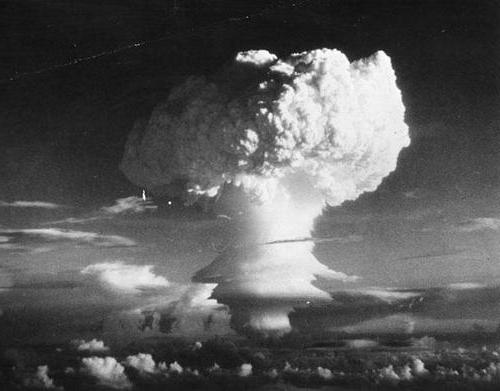
The test of the first hydrogen warhead was conducted by the Americans in 1952. In the modern sense, this device can hardly be called a bomb. It was a three-story building filled with liquid deuterium. The first hydrogen bomb explosion in the USSR was made six months later. Soviet thermonuclear ammunition RDS-6 was blown up in August 1953 near Semipalatinsk. The largest hydrogen bomb with a capacity of 50 megatons (Tsar Bomb) of the USSR was tested in 1961. Wave after the explosion of ammunition circled the planet three times.
The history of the atomic bomb, and in particular weapons, begins in 1939, with the discovery made by Joliot Curie. From that moment on, scientists realized that the chain reaction of uranium can become not only a source of tremendous energy, but also a terrible weapon. And so, the basis of the atomic bomb is the use of nuclear energy, which is released during a nuclear chain reaction.
The latter implies the process of fission of heavy nuclei or the synthesis of light nuclei. As a result, the atomic bomb is a weapon of mass destruction, due to the fact that in the shortest period of time a huge amount of intranuclear energy is released in a small space. With the input of this process, it is customary to allocate two key places.
The first is the center of a nuclear explosion, where the process is directly proceeding. And secondly, this is the epicenter, which in its essence represents the projection of the process itself onto the surface (earth or water). Also, a nuclear explosion releases such an amount of energy that when it is projected onto the earth, seismic shocks appear. And the range of propagation of such oscillations is incredibly great, although they cause significant damage to the environment only at a distance of only a few hundred meters.
Further, it is worth noting that a nuclear explosion is accompanied by the release of a large amount of heat and light, which forms a bright flash. Moreover, in its power it exceeds many times the power of the rays of the sun. Thus, the defeat of light and heat can be obtained at a distance of even several kilometers.
But one highly dangerous type of destruction of an atomic bomb is radiation, which is formed during a nuclear explosion. The duration of the impact of this phenomenon is low, averaging 60 seconds, only the penetrating power of this wave is striking.
As for the atomic bomb, it includes a number of different components. As a rule, there are two main elements of this type of weapon: the body and the automation system.
The case contains nuclear charge and automatics, and it is this one that performs a protective function in relation to various types of effects (mechanical, thermal, and so on). And the role of the automation system is to ensure that the explosion occurs at a clearly defined time, and not earlier or later. The automation system consists of such systems as: emergency disruption; protection and cocking; power supply; sensors for undermining and undermining the charge.
But atomic bombs are delivered using ballistic, cruise and anti-aircraft missiles. Those. nuclear munitions may be part of the bombs, torpedoes, land mines and so on.

And even the detonation systems for the atomic bomb can be different. One of the simplest systems is an injection system, when a projectile hits a target, with the subsequent formation of a supercritical mass, becomes the impetus for a nuclear explosion. It was to this type of atomic bombs that the first bomb exploded over Hiroshima in 1945 containing uranium. In contrast, the bomb dropped on Nagasaki that same year was a plutonium bomb.
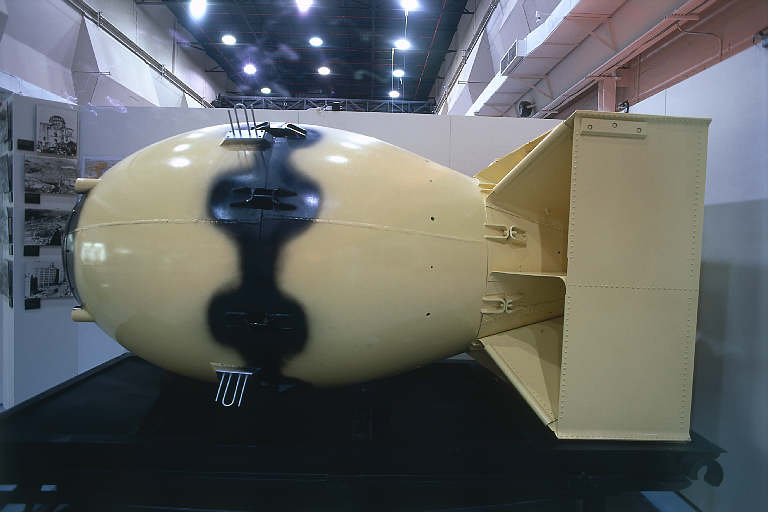
After such a vivid demonstration of the power and strength of atomic weapons, it instantly fell into the category of the most dangerous means of mass destruction. Speaking about the types of atomic weapons, it should be mentioned that they are determined by the size of the caliber. So, at the moment there are three main caliber for this weapon, it is small, large and medium. The power of the explosion, most often, is characterized by a TNT equivalent. For example, a small caliber of atomic weapons implies a charge power equal to several thousand tons of TNT. A more powerful atomic weapon, more precisely an average caliber, already amounts to tens of thousands of tons of TNT, and, finally, the latter is already measured in millions. But at the same time, one should not confuse the concept of atomic and hydrogen weapons, which, in general, are called nuclear weapons. The main difference between atomic weapons and hydrogen is the fission reaction of the nuclei of a number of heavy elements such as plutonium and uranium. A hydrogen weapon implies a process of synthesis of the nuclei of atoms of one element into another, i.e. helium from hydrogen.
The first test of the atomic bomb
The first test of atomic weapons was carried out by the American armed forces on July 16, 1945 in a place called Almogordo, which showed the full power of atomic energy. After that, the atomic bombs held by US forces were loaded onto a warship and sent to the shores of Japan. The refusal of the government of Japan to peace dialogue allowed in action to show the full power of atomic weapons, the victims of which first became the city of Hiroshima, and a little later Nagasaki. Thus, on August 6, 1945, for the first time, atomic weapons were used on civilians, as a result of which the city was practically erased into the faces of the earth by shock waves. More than half of the city dwellers died for the first time atomic attack days, and totaled about two hundred forty thousand people in total. And just four days later, two planes with a dangerous cargo aboard left the US military base, the targets of which were Kokura and Nagasaki. And if Kokura, engulfed in impenetrable smoke, was a difficult target, in Nagasaki the target was hit. Ultimately, the atomic bomb in Nagasaki in the first days killed 73 thousand people from injuries and radiation to these victims added a list of thirty-five thousand people. In this case, the death of the last victims was rather painful, since the effect of radiation is incredibly destructive.
Factors of the destruction of atomic weapons
Thus, atomic weapons have several types of destruction; light, radioactive, shock wave, penetrating radiation and electromagnetic pulse. With the formation of light radiation after the explosion of a nuclear weapon, which later turns into destructive heat. Then comes the turn of radioactive contamination, which is dangerous only for the first time hours after the explosion. The shock wave is considered to be the most dangerous stage of a nuclear explosion, because in a matter of seconds it causes enormous damage to various buildings, equipment and people. But penetrating radiation is very dangerous for the human body, and often becomes the cause of radiation sickness. Electromagnetic pulse affects technology. Together, all this makes nuclear weapons very dangerous.
Nuclear weapons (or atomic weapons) - a set of nuclear weapons, their means of delivery to the target and control equipment; refers to weapons of mass destruction along with biological and chemical weapons. Nuclear weapons - explosive weapons, based on the use of nuclear energy, released during the nuclear chain reaction of fission of heavy nuclei or the thermonuclear fusion reaction of light nuclei.
People who have been directly exposed to the damaging factors of a nuclear explosion, in addition to physical damage, experience a powerful psychological impact from the terrifying look of the picture of the explosion and destruction. Electromagnetic impulse does not directly affect living organisms, but can disrupt electronic equipment.
Hiroshima - 66 years later
August 6 marks 66 years since the day when the United States of America dropped an atomic bomb on the Japanese city of Hiroshima. At that time, about 250,000 people lived in Hiroshima. An American B-29 Superfortress bomber called “Enola Gay” flew into the air from Tinian Island early in the morning of August 6 with the only 4,000 kg uranium bomb called the “Little Boy”. At 8:15, the bomb “baby” was dropped from a height of 9,400 meters above the city and spent 57 seconds in a free fall. At the time of detonation, a small explosion provoked an explosion of 64 kg of uranium. Of these 64 kg, only 7 kg passed the splitting stage, and from this mass only 600 mg turned into energy — explosive energy, which burned everything in its path for several kilometers, leveling the city with the earth by a blast wave, launching a series of fires and plunging all life into radiation flux. It is believed that about 70,000 people died immediately, another 70,000 died from injuries and radiation by 1950. Today, in Hiroshima, near the epicenter of the explosion, there is a memorial museum, the purpose of which is to promote the idea that nuclear weapons cease to exist.
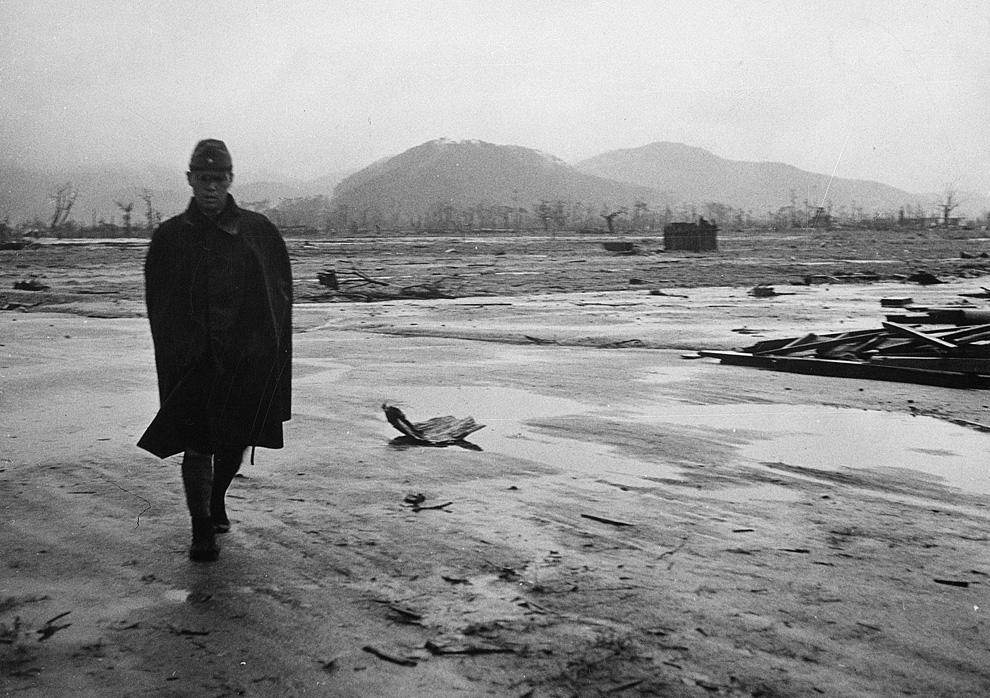
1. A Japanese soldier walks through the desert in Hiroshima, in September 1945, just a month after the bombing. This series of photographs depicting the suffering of people and ruins was presented by the American Navy. (U.S. Department of Navy)

2. A view of Hiroshima from the air shortly before the bomb was dropped on the city in August 1945. It shows a densely populated area of the city on the Motoyasu River (Hiroshima: United States Strategic Bombing Survey Archive, ICP Acquisitions Committee, 2006)
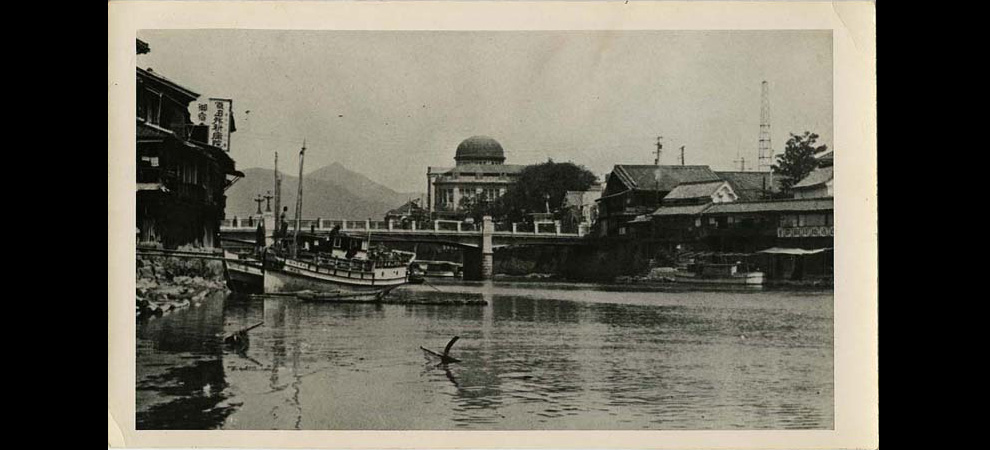
3. Photograph of Hiroshima taken before August 1945 - upstream of the Motoyasu River to the most famous place of Hiroshima - the dome of the exhibition center, located in close proximity to the epicenter. Originally, this building was designed by Czech architect Jan Letzel, it was completed in April 1915. (Hiroshima: United States Strategic Bombing Survey Archive, ICP Acquisitions Committee, 2006)

4. Data from the US Air Force - Hiroshima map before the bombing, where you can see a circle at 304 m from the epicenter, which instantly disappeared from the face of the earth. (U.S. National Archives and Records Administration)
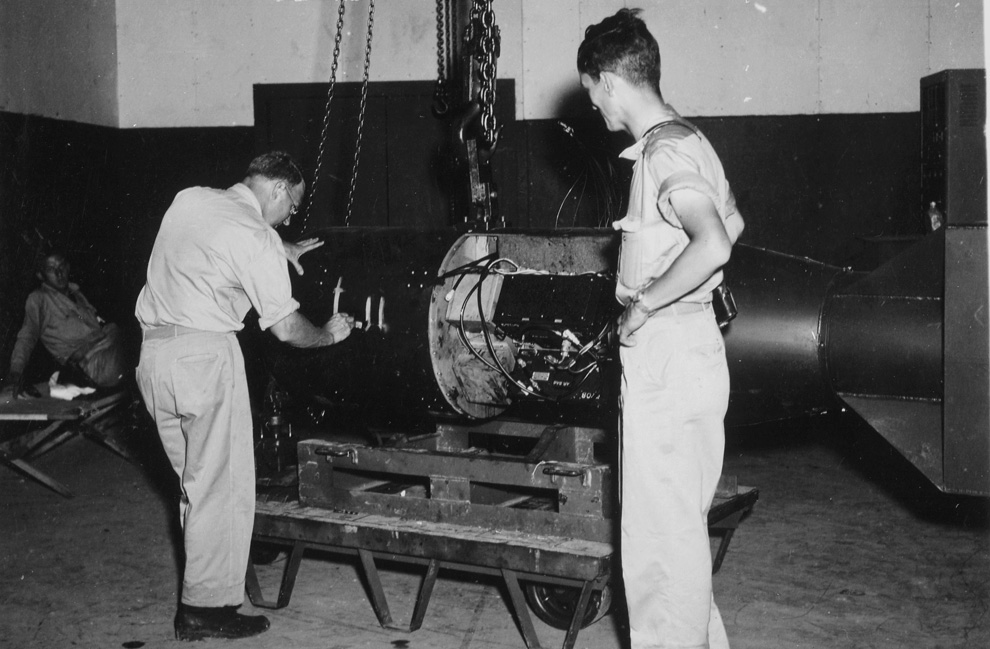
5. Commander A.F. Birch (left) numbers the bomb codenamed “Kid” before loading it onto a trailer in Assembly Building 1 before the final loading of the bomb aboard a B-29 Superfortress bomber “Enola Gay” based on the 509th summary group on Tinian Island off the Marianna Islands in 1945. Physicist Dr. Ramsay (right) will receive the Nobel Prize in Physics in 1989. (U.S. National Archives)
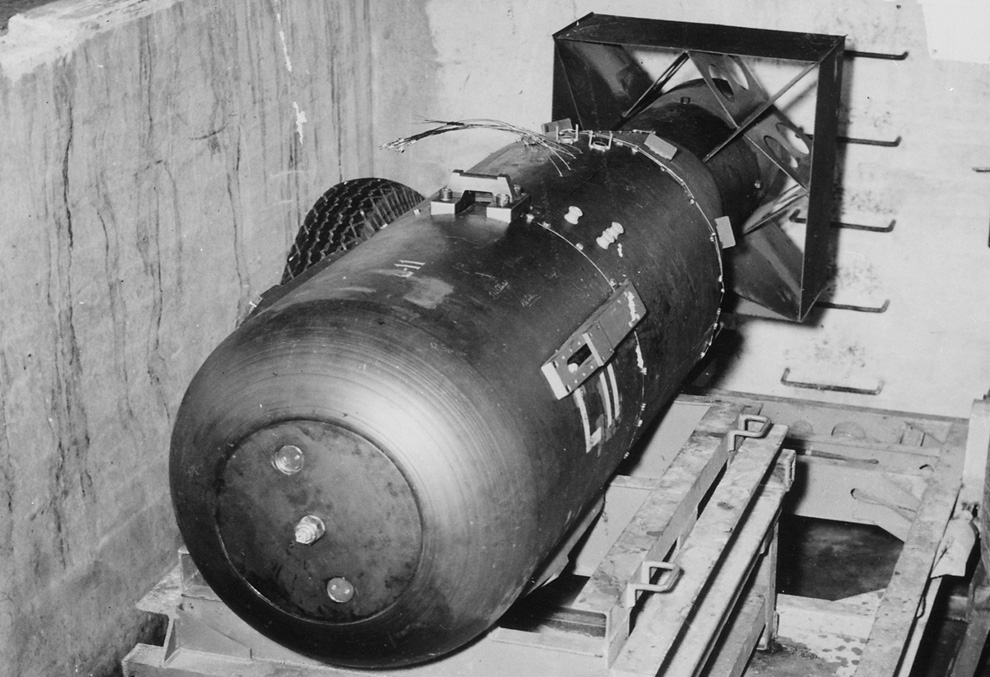
6. “The Kid” rests on a trailer in a pit above the B-29 Superfortress “Enola Gay” bomber gateway based on the 509th consolidated group on the Mariana Islands in 1945. The “kid” was 3 m long and weighed 4,000 kg, but contained only 64 kg of uranium, which was used to provoke a chain of atomic reactions and a subsequent explosion. (U.S. National Archives)
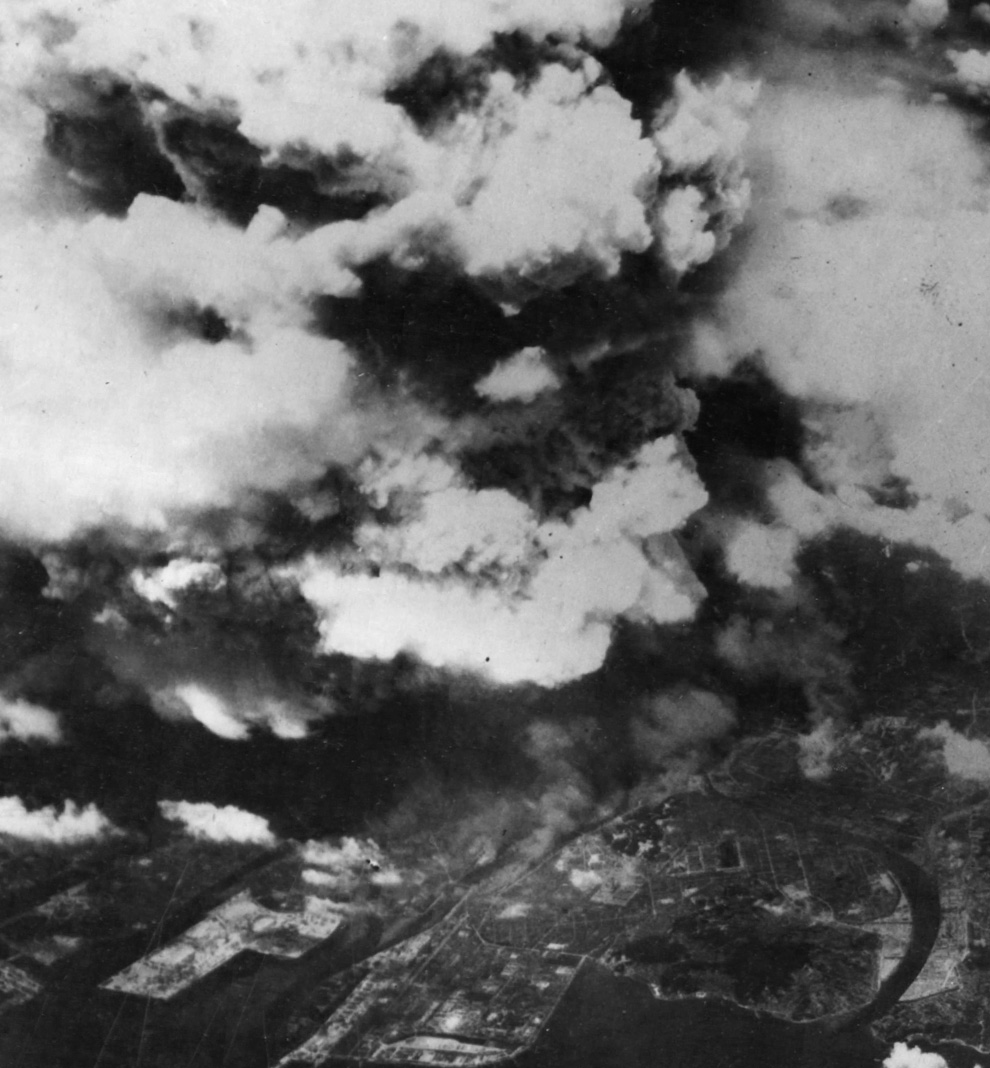
7. A photo taken from one of the two American bombers of the 509th combined group, shortly after 8:15, August 5, 1945, shows smoke rising from an explosion over the city of Hiroshima. By the time of the shooting, a flash of light and heat from a fiery ball with a diameter of 370 m had already occurred, and the blast wave, moving at the speed of light, quickly dissipated, already causing the main damage to buildings and people within a radius of 3.2 km. (U.S. National Archives)

8. The growing nuclear “mushroom” over Hiroshima soon after 8:15, August 5, 1945. When a portion of uranium in a bomb passed the cleavage stage, it was instantly turned into energy 15 kilotons of trotyl, heating a massive fireball to a temperature of 3,980 degrees Celsius. Heated to the limit, the air and smoke quickly rose in the atmosphere, like a huge bubble, raising behind itself a column of smoke. By the time this photo was taken, the smog had risen to a height of 6,096.00 m above Hiroshima, while the smoke from the explosion of the first atomic bomb had spread to 3,048.00 m at the base of the column. (U.S. National Archives)
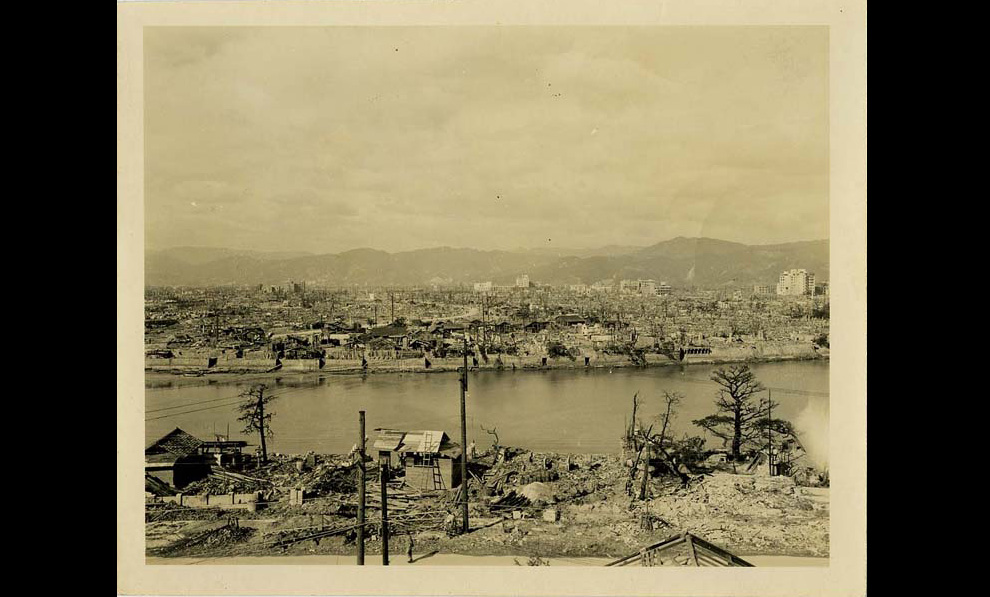
9. View of the destroyed Hiroshima in the autumn of 1945 on one branch of the river, passing through the delta, on which the city stands. (Hiroshima: United States Strategic Bombing Survey Archive, ICP Acquisitions Committee, 2006)

10. View of the Hiroshima epicenter in the fall of 1945 — complete destruction after the discharge of the first atomic bomb. The photo shows the hypocenter (the center point of the explosion source) - approximately above the Y-shaped intersection in the center to the left. (U.S. National Archives)
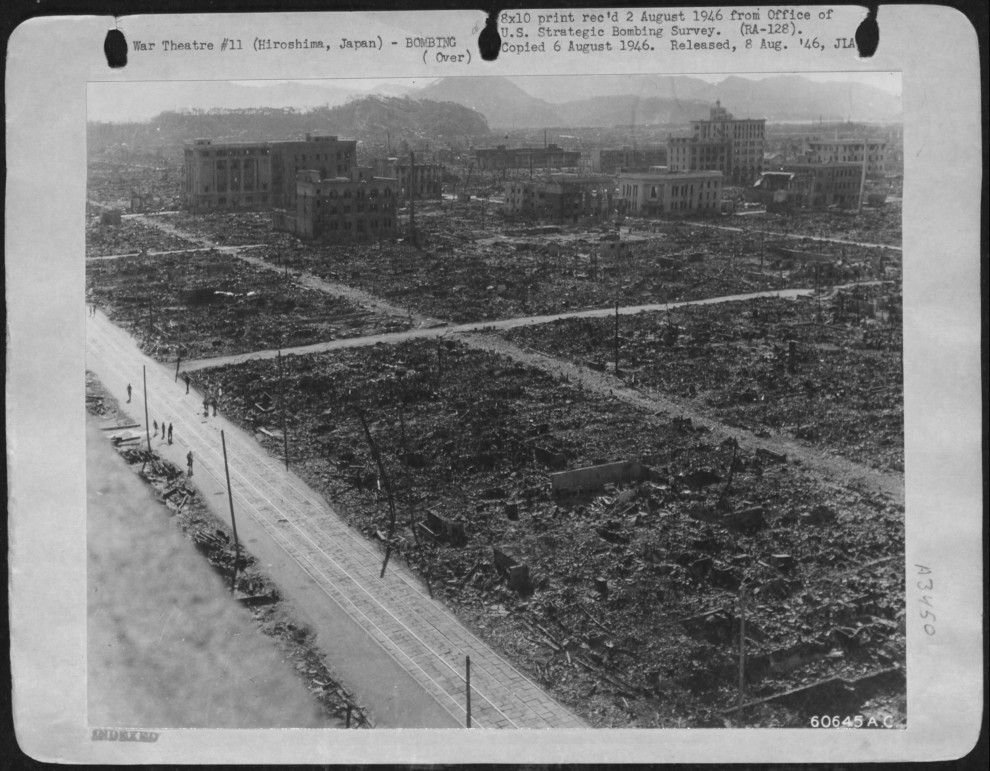
11. Part of the panoramic view of Hiroshima destroyed, made with the help of five cameras from the roof of the Chamber of Commerce on October 6, 1945, 2 months after the tragedy. On the left in the background are the ruins of the Bank of Geibi and Shima Hospital. In the center is the destroyed building of the exhibition center, behind it is the bridge over the Matoyasu river, just before the hypocenter of the explosion. On the right is still the existing building of the Red Cross Hospital, whose roof was damaged by the blast wave. In the distance, to the right is the bridge at the confluence of the Matoyasu and Ota rivers. (U.S. National Archives)
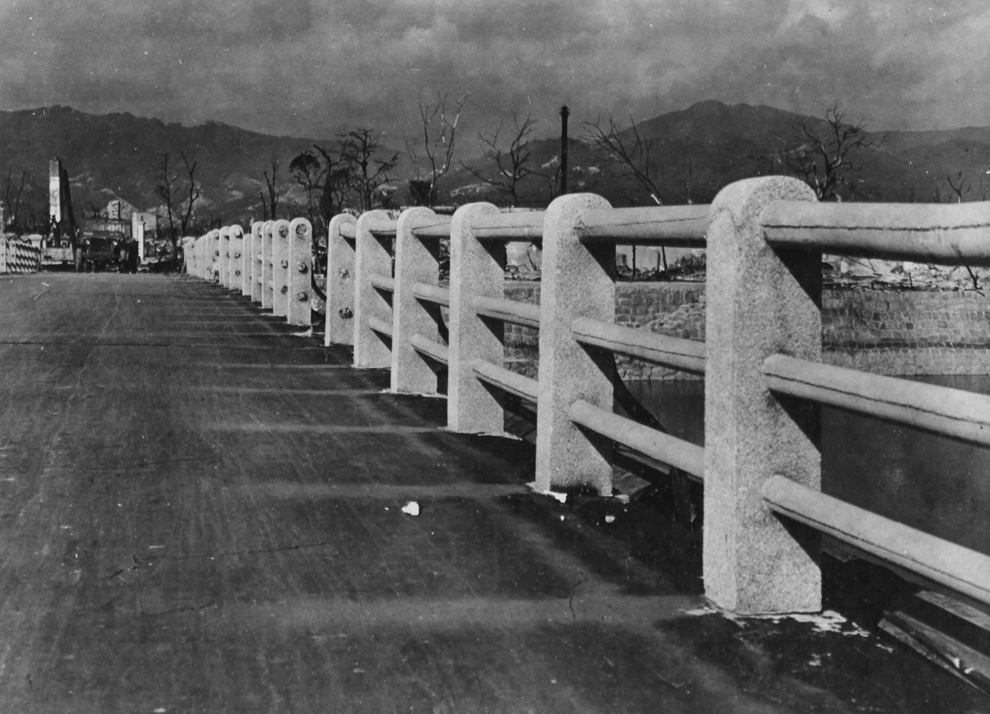
12. The bridge over the River Ota is 880 meters from the hypocenter of the explosion over Hiroshima. Notice how the road burned down, and on the left you can see ghostly imprints where the concrete columns once protected the surface. (U.S. National Archives)
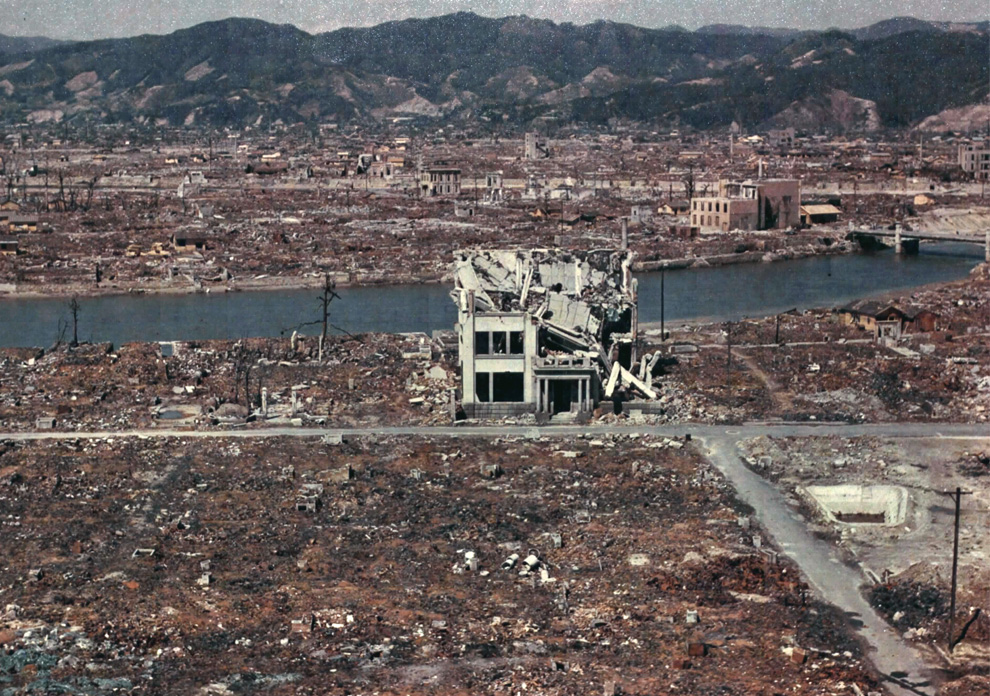
13. Color photograph of destroyed Hiroshima in March 1946. (U.S. National Archives)
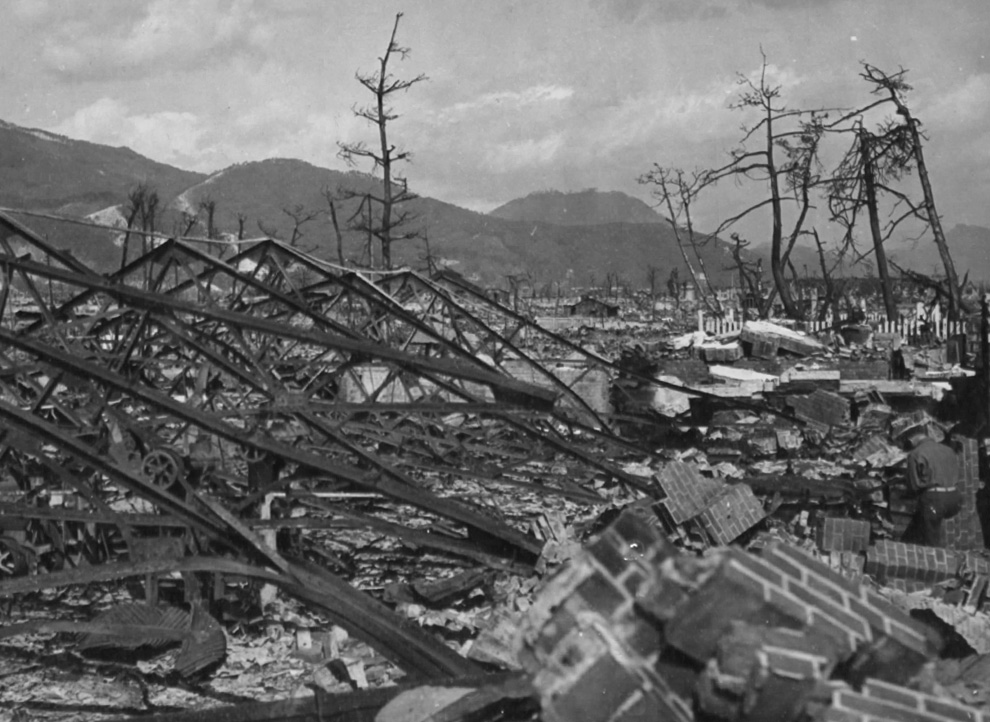

15. Ruined street in Hiroshima. See how the sidewalk was raised, and a drainpipe protrudes from the bridge. Scientists say it happened because of the vacuum created by pressure from an atomic explosion. (U.S. National Archives)
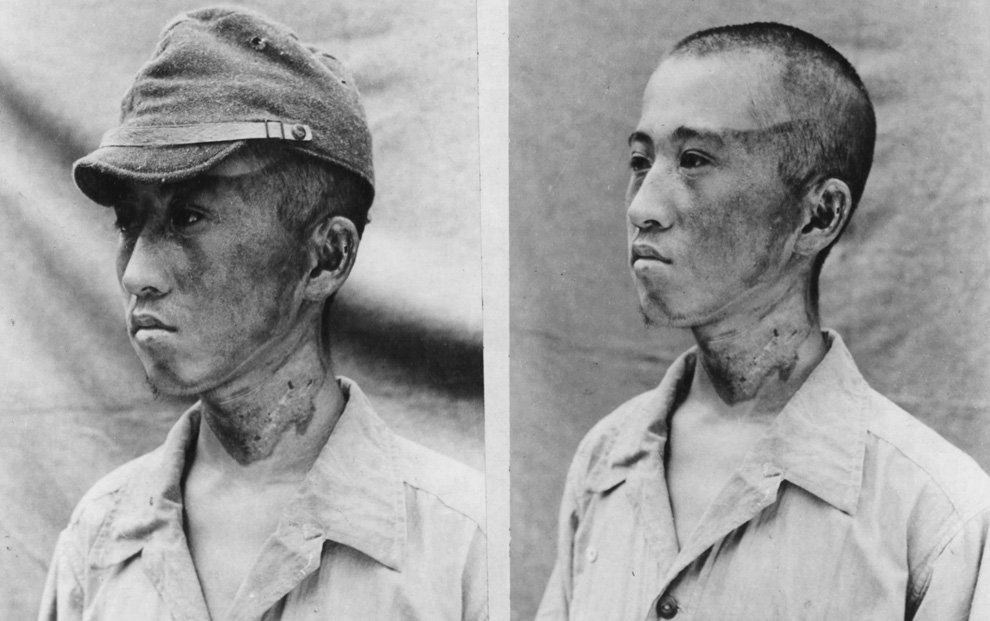
16. This patient (picture taken by the Japanese military on October 3, 1945) was located approximately 1,981.20 m from the epicenter, when radiation beams overtook him on the left. Cap protected part of the head from burns. (U.S. National Archives)
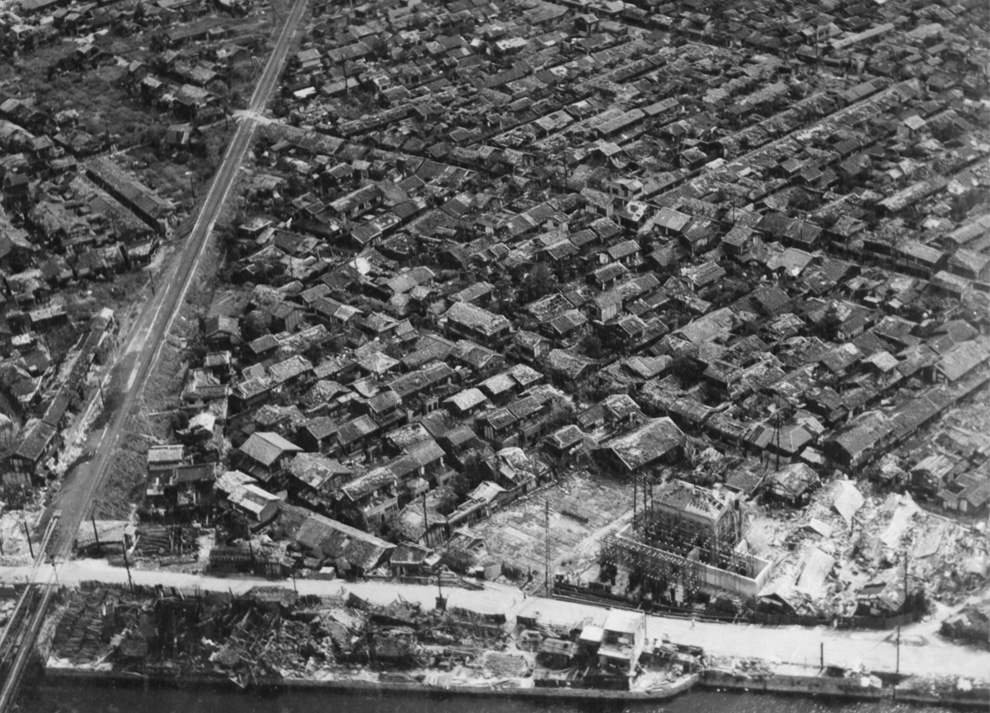
17. The densely populated area of Hiroshima weeks after the explosion at the edge of the heavily impacted area (note the building below, which was razed to the ground). (U.S. National Archives)

18. Crooked iron bars - all that remains of the theater building, located about 800 meters from the epicenter. (U.S. National Archives)
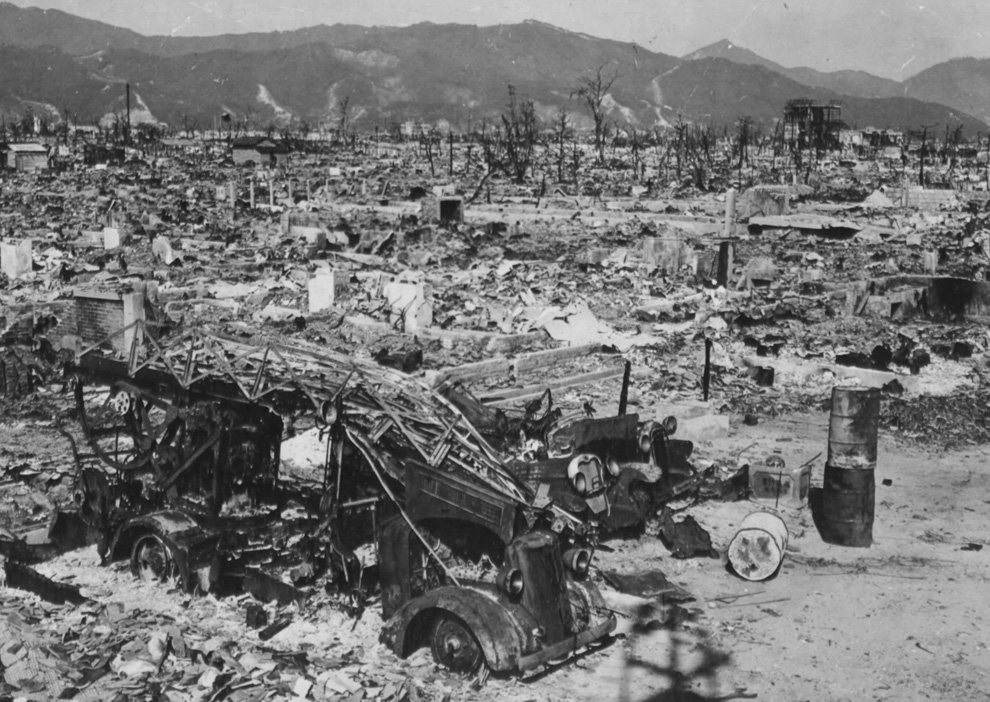
19. The Hiroshima fire department lost its only car when the western station was destroyed by an atomic bomb. The station was located 1,200 meters from the epicenter. (U.S. National Archives)

20. View of Hiroshima from the air in the autumn of 1945. In the center at the top of the visible hypocenter and the dome of the atomic bomb. (U.S. National Archives)
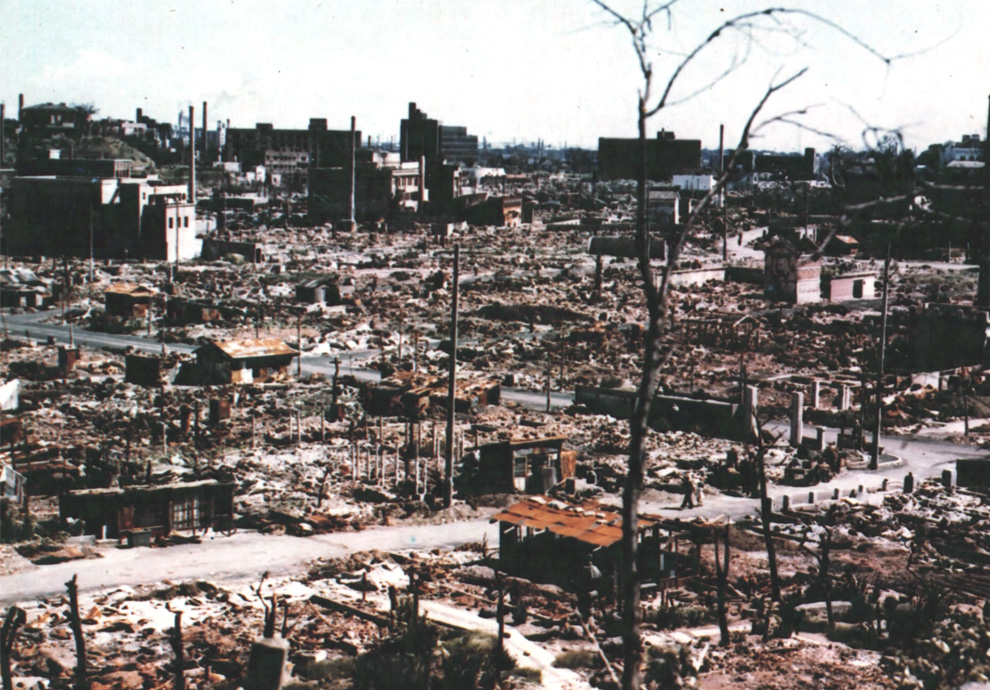
21. Color photograph of the ruins of central Hiroshima in the autumn of 1945. (U.S. National Archives)
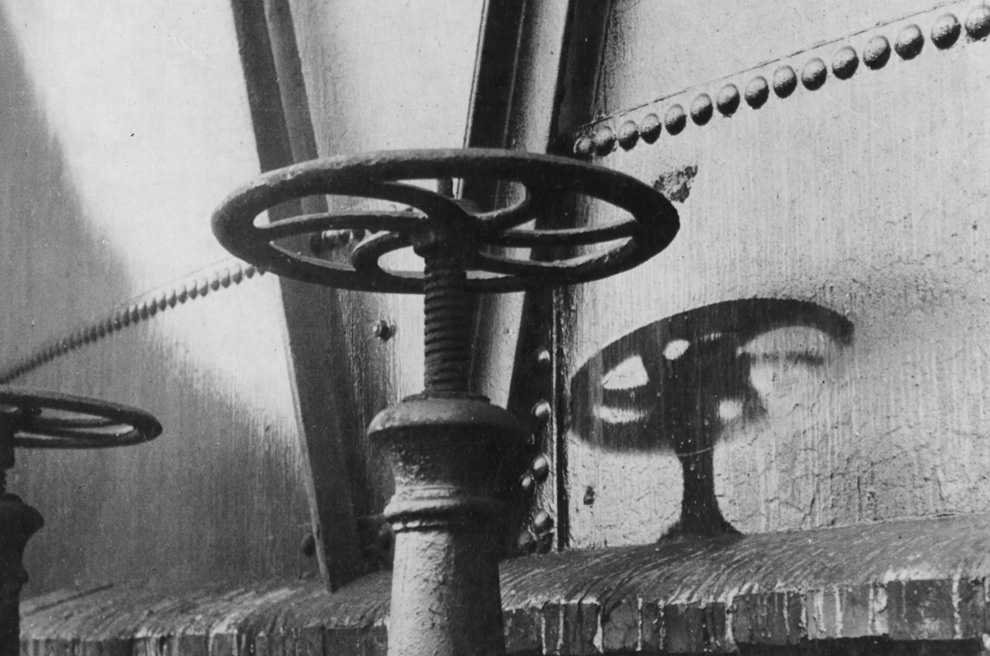
22. "Shadow" valve handles on the painted wall of the gas tank after the tragic events in Hiroshima. Radiation heat instantly burned paint where the radiation rays passed without hindrance. 1 920 m from the epicenter. (U.S. National Archives)
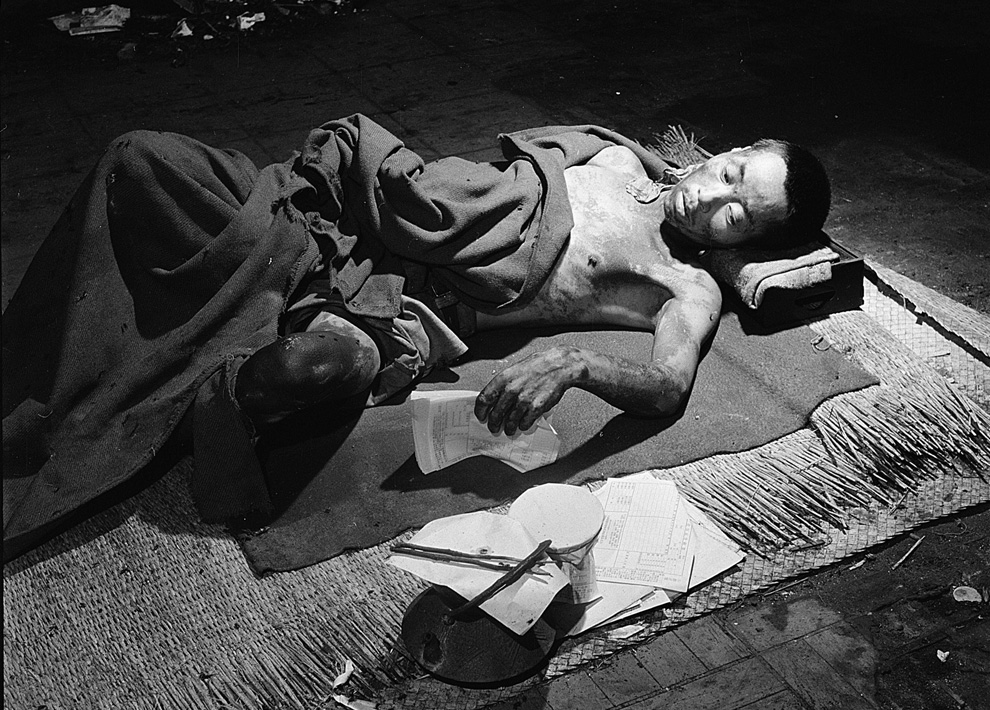
23. The victim of the bombing in Hiroshima lies in a temporary hospital, located in one of the surviving buildings of the bank in September 1945. (U.S. Department of Navy)
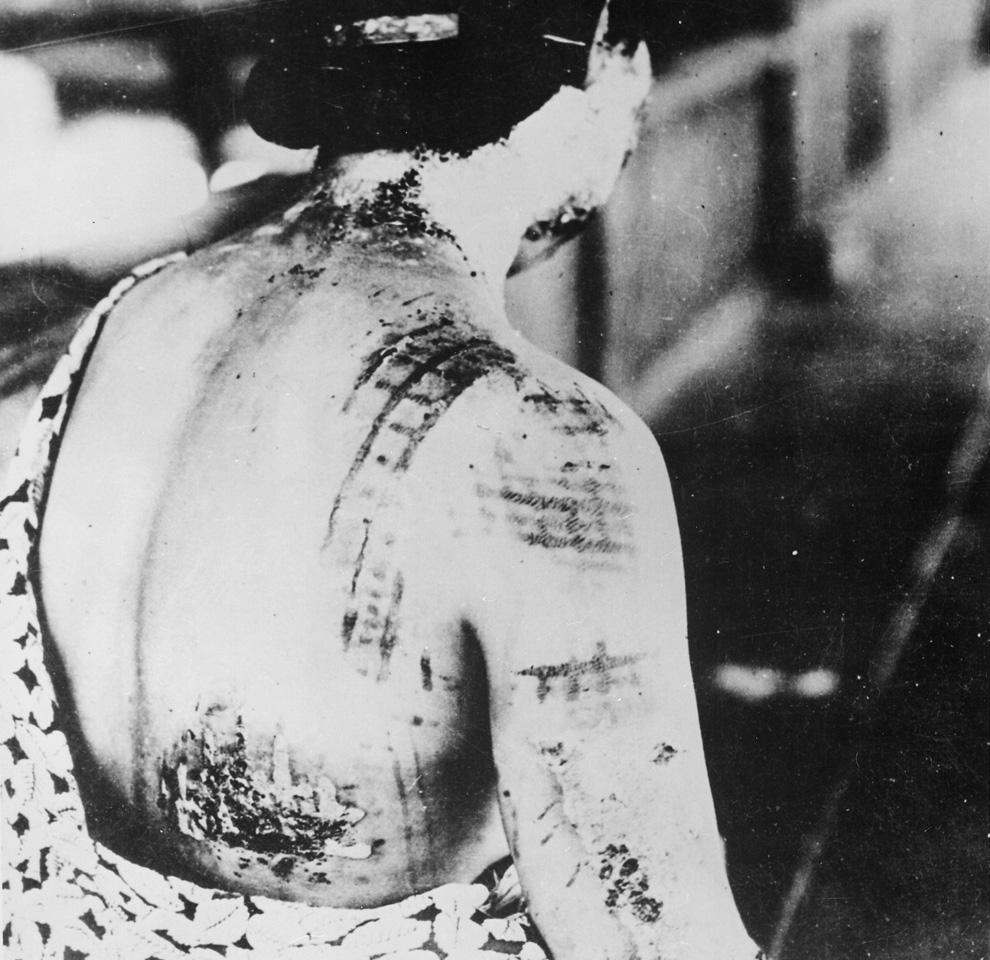
24. From the caption to the photo of this Hiroshima victim: "The burns on the patient's skin remained in the form of dark spots from the kimono that was on the victim at the time of the explosion." (U.S. National Archives)
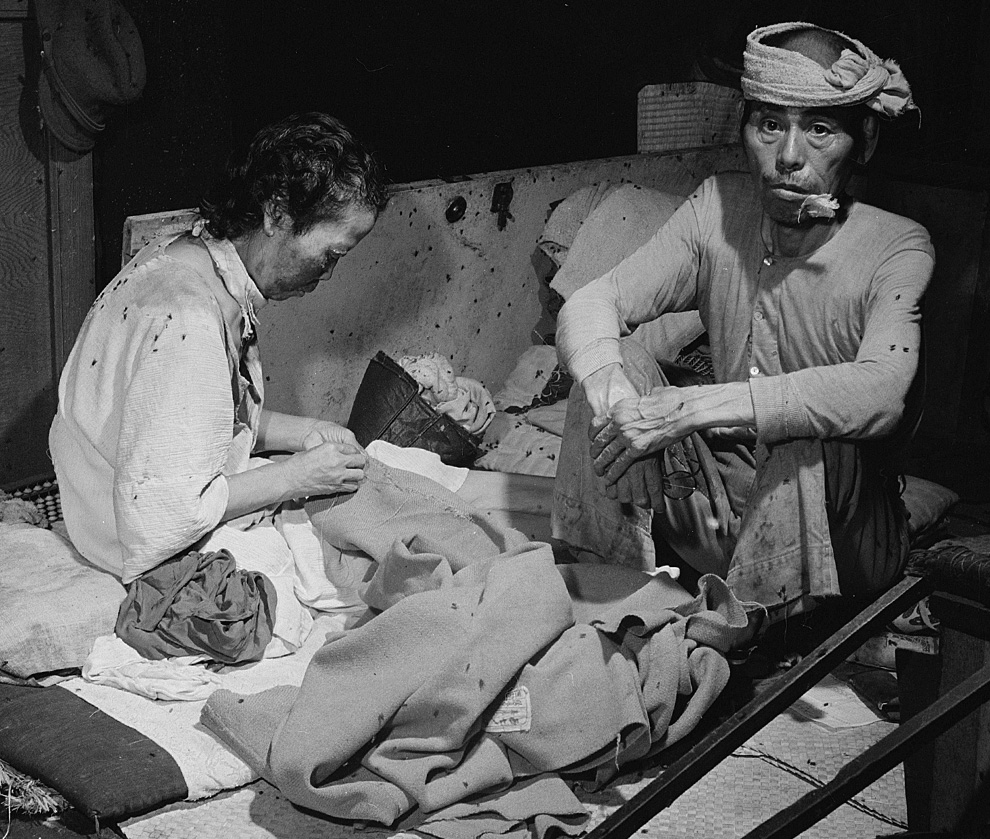
25. Victims of an explosion in a flies-filled temporary hospital in a bank building in Hiroshima on September 15, 1945. (U.S. Department of Navy)
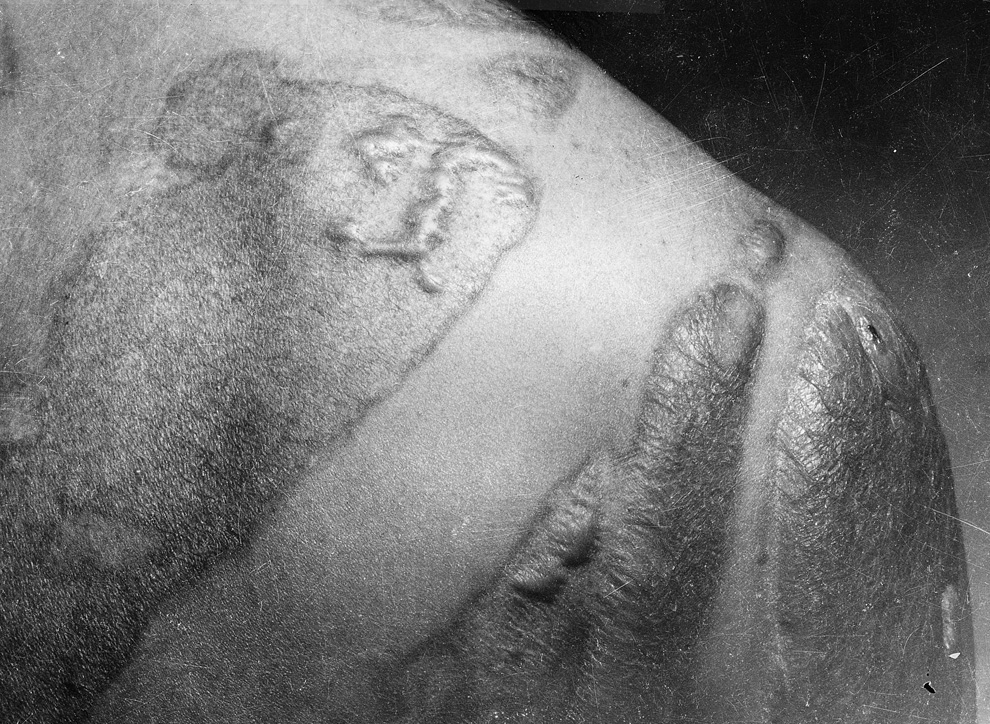
26. Keloid scars on the back and shoulders of an Hiroshima bombing victim. Scars were formed where the victim's skin was not protected from direct radiation rays. (U.S. National Archives)
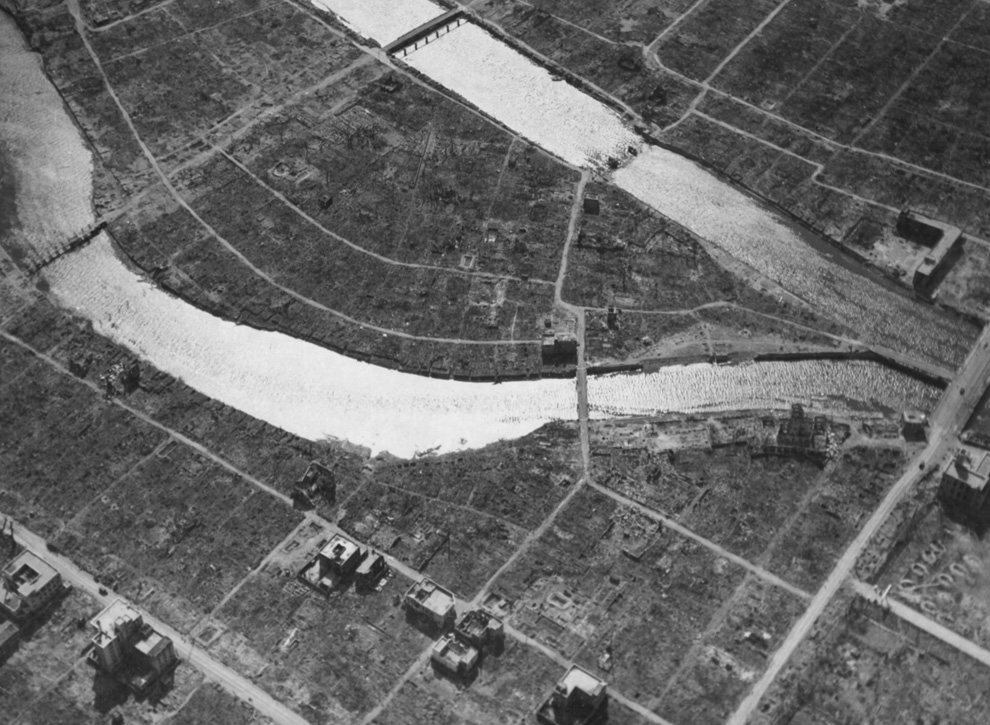
27. Aerial view of the epicenter and the now famous Atomic Bomb Dome in Hiroshima a few weeks after the events of August 6, 1945. (U.S. National Archives)

28. Man looks at the ruins left after the atomic bomb in Hiroshima. (AP Photo)
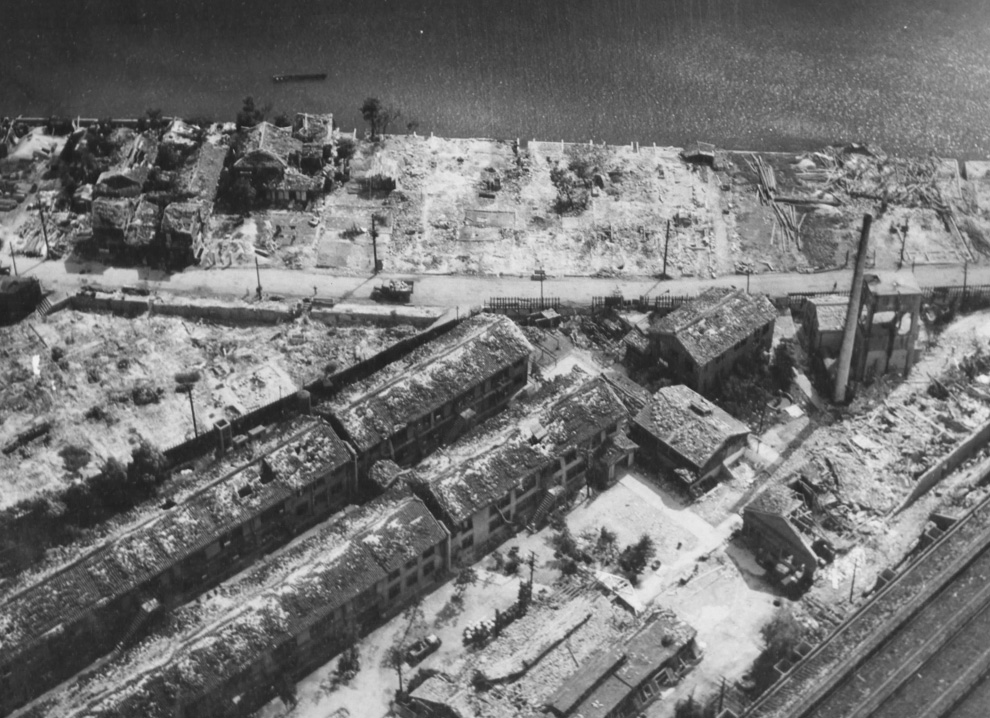
29. Top view of the destroyed industrial area of Hiroshima in the autumn of 1945. (U.S. National Archives)
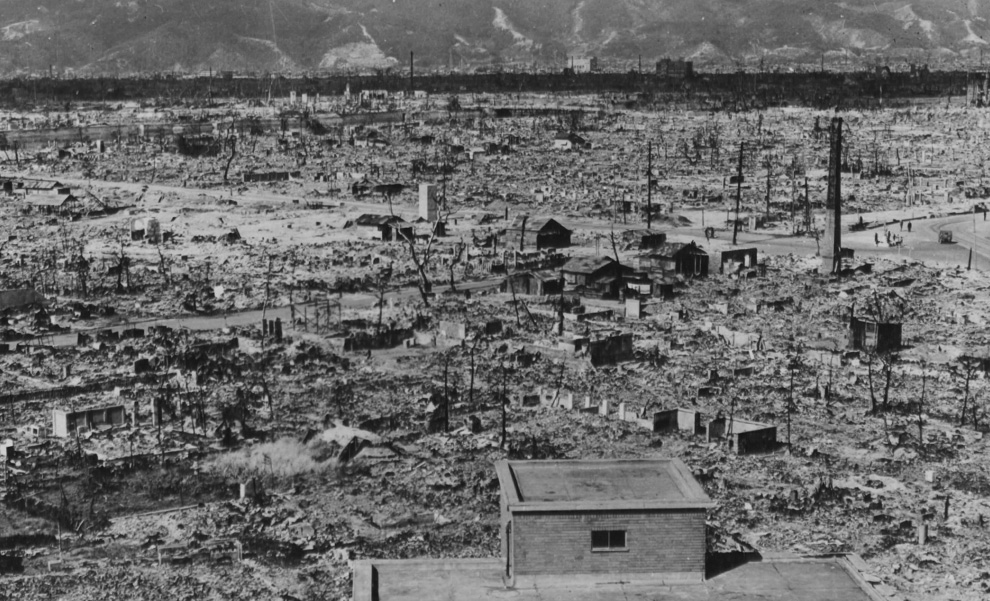
30. View of Hiroshima and the mountains in the background in the autumn of 1945. The picture was taken from the ruins of the Red Cross Hospital, less than 1.60 km from the hypocenter. (U.S. National Archives)
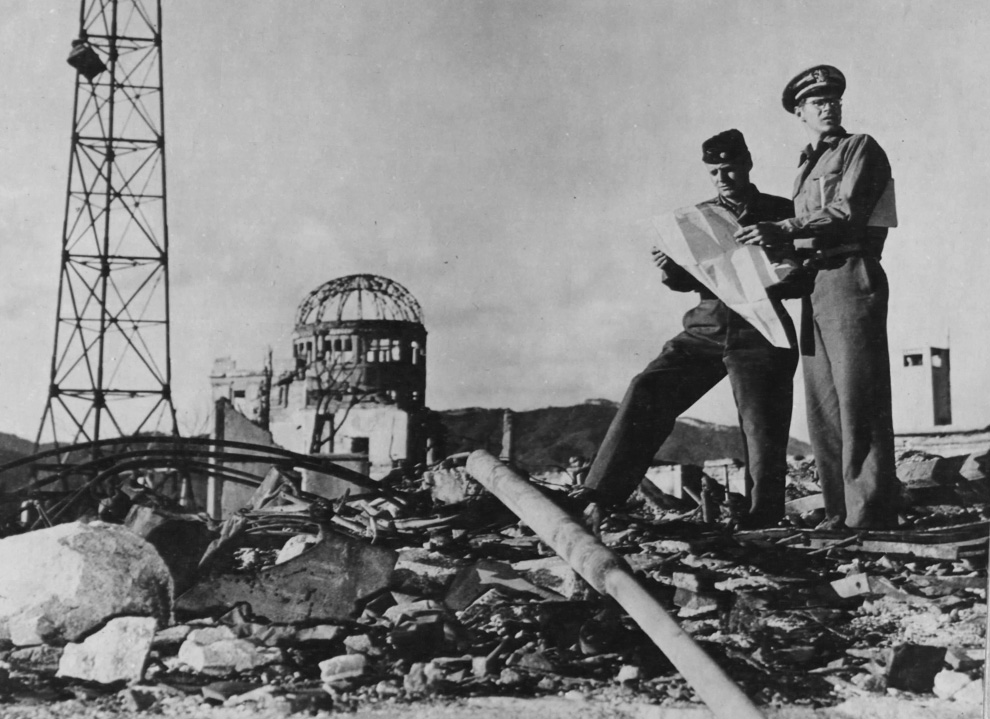
31. Members of the US Army explore the area around the epicenter in Hiroshima in the fall of 1945. (U.S. National Archives)
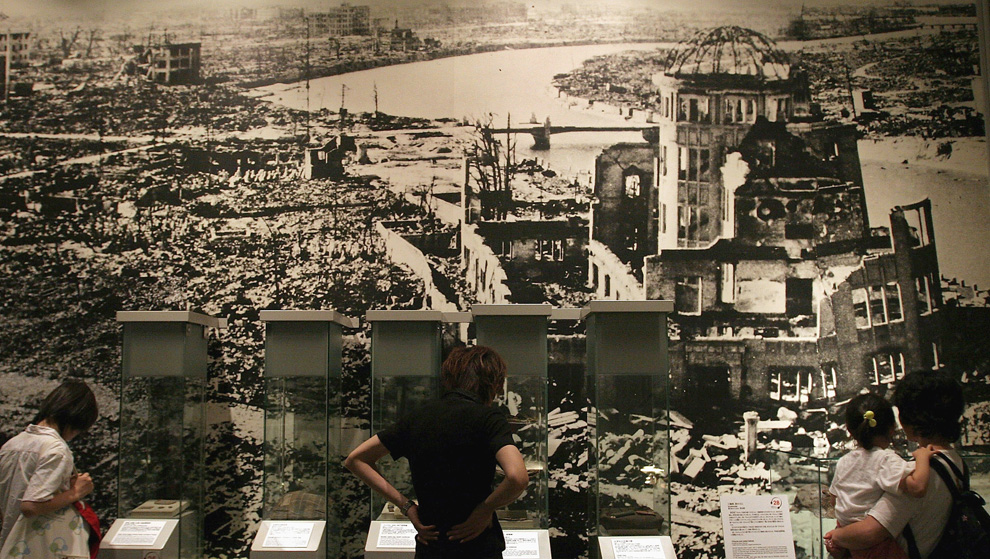
32. Visitors to the Hiroshima Memorial Park look at the panoramic view of the effects of the atomic explosion on July 27, 2005 in Hiroshima. (Photo by Junko Kimura / Getty Images)
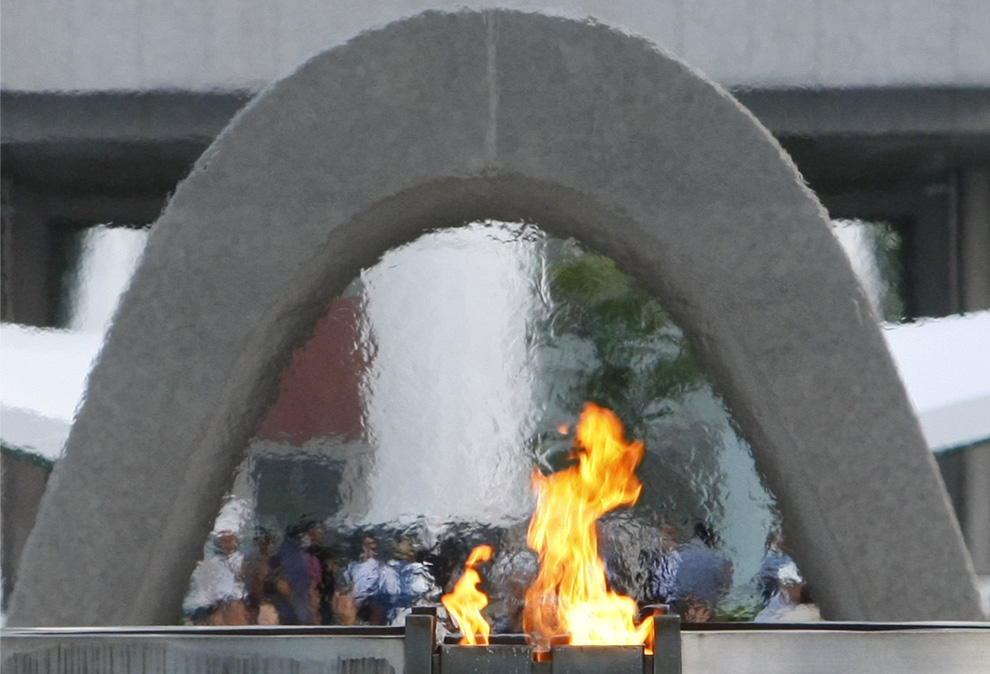
33. Memorial fire in honor of the victims of the atomic explosion on the monument in the memorial park of Hiroshima, Western Japan, Tuesday, April 4, 2009. The fire has been constantly burning since it was lit on August 1, 1964. The fire will burn until "until all the atomic weapons of the earth disappear forever." (AP Photo / Shizuo Kambayashi)
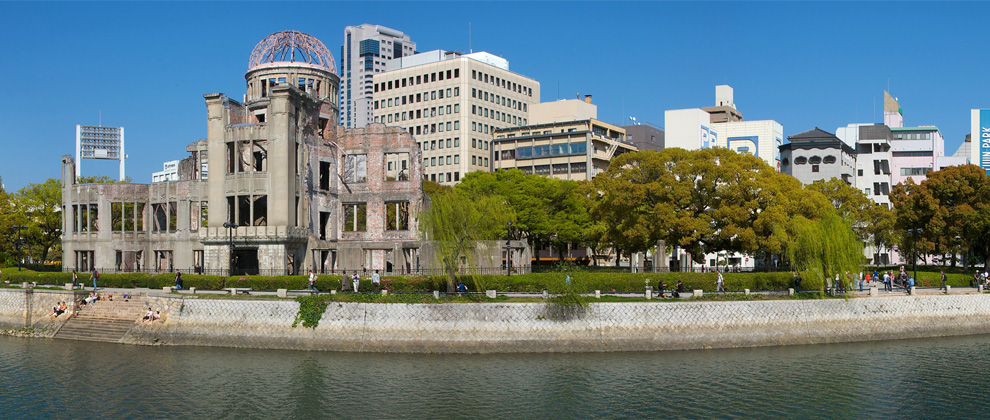
34. Hiroshima today - details of the panoramic view of the Peace Memorial in Hiroshima on April 14, 2008. (Dean S. Pemberton / CC BY-SA)
Source: bigpicture.ru
History and facts of nuclear testing.
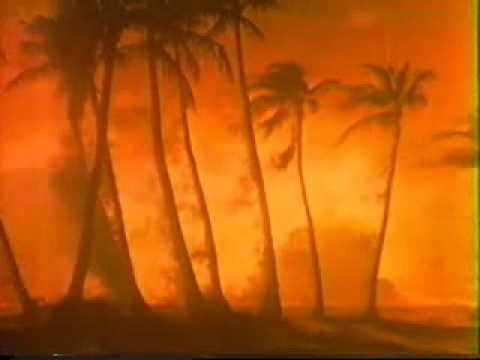
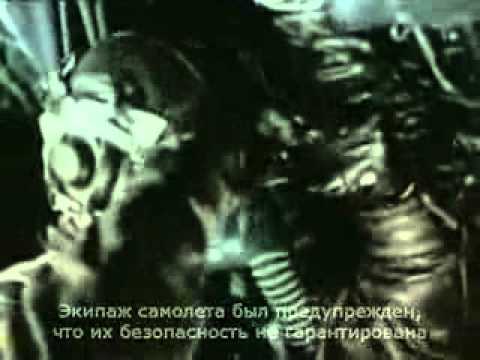
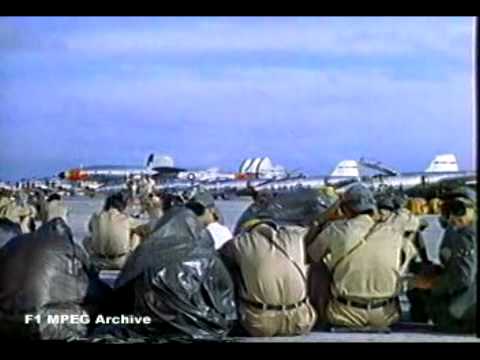
Since the first atomic explosion, codenamed Trinity, in 1945, nearly two thousand tests of atomic bombs were carried out, most of which took place in the 1960s and 1970s. When this technology was new, tests were carried out frequently, and they represented the spectacle else. All of them led to the development of new and powerful nuclear weapons. But since the 1990s, governments of various countries began to limit future nuclear testing - to take at least the US moratorium and the UN comprehensive test-ban treaty. Who will take care of those experienced engineers who are now virtually out of work, and should we act as masters with our stockpiles of nuclear weapons? This issue contains photos of the first 30 years of atomic bomb testing.
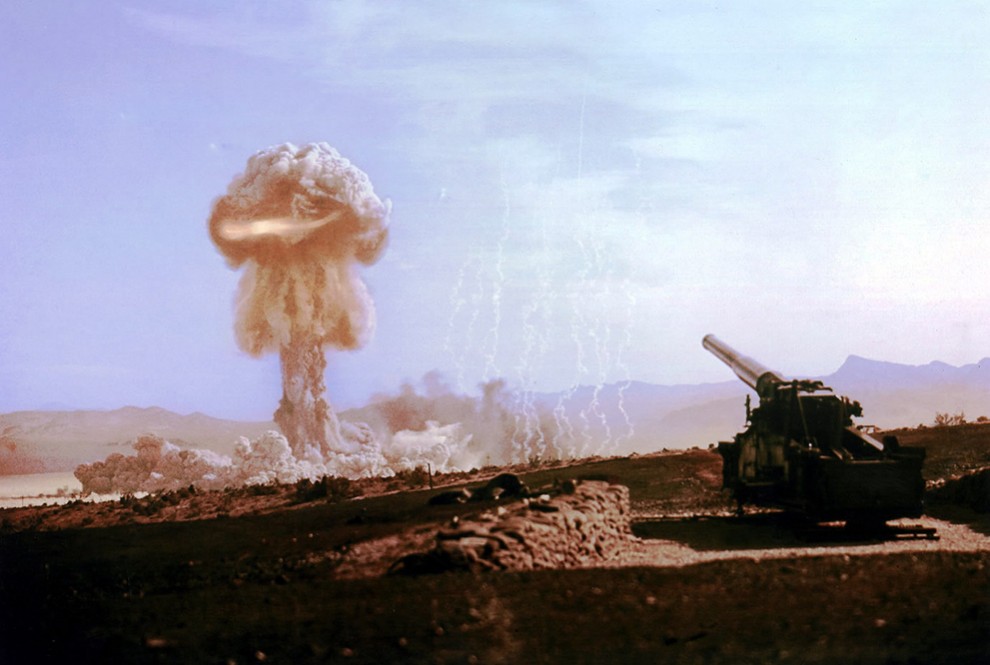
1. The Upshot-Knothole Grable nuclear test explosion in the state of Nevada on May 25, 1953. The 280-millimeter nuclear projectile flew from an M65 cannon, detonated in the air — about 150 meters above the ground — and produced an explosion of 15 kilotons.
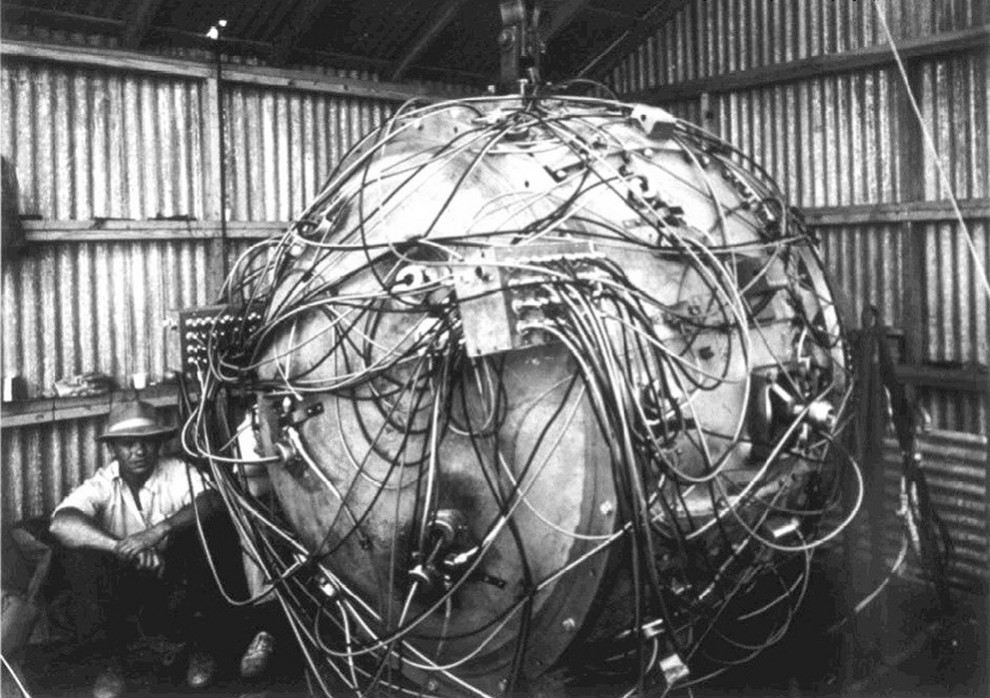
2. Open wiring of a nuclear device with the code name "The Gadget" (the unofficial name of the project "Trinity") - the first atomic explosion test. The device was prepared for an explosion that occurred on July 16, 1945. (U.S. Department of Defense)

3. The shadow of the director of the Los Alamos national laboratory, Jay Robert Oppenheimer, overseeing the assembly of the Gadget projectile. (U.S. Department of Defense)
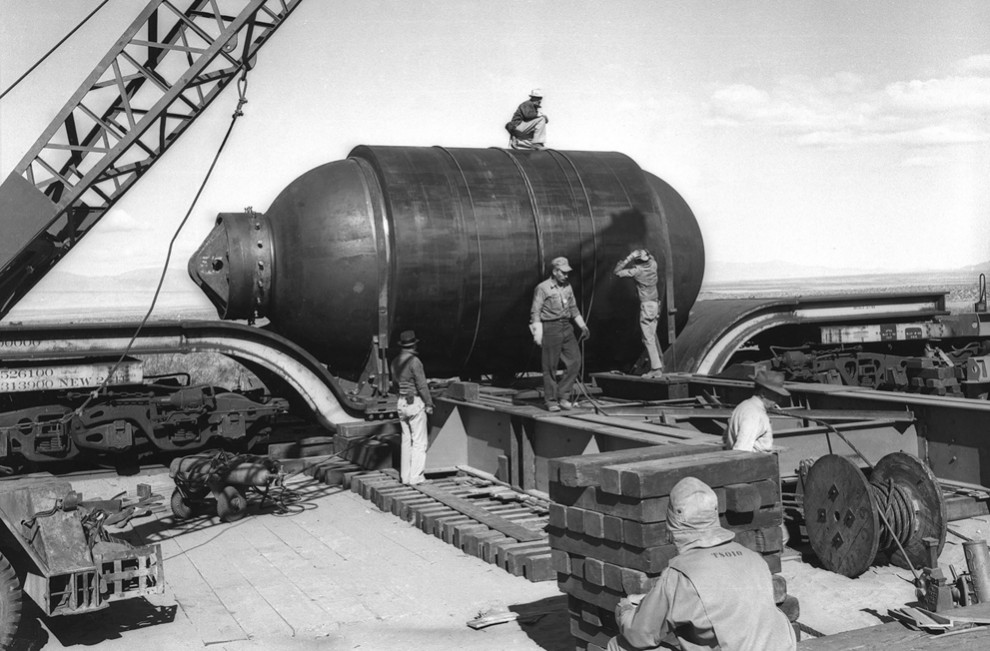
4. The 200-ton Jumbo steel container used in the Trinity project was made to recover plutonium if an explosive suddenly triggers a chain reaction. In the end, Jumbo was not useful, but it was placed near the epicenter to measure the effects of the explosion. Jumbo survived the explosion, which is not the case with his supporting frame. (U.S. Department of Defense)
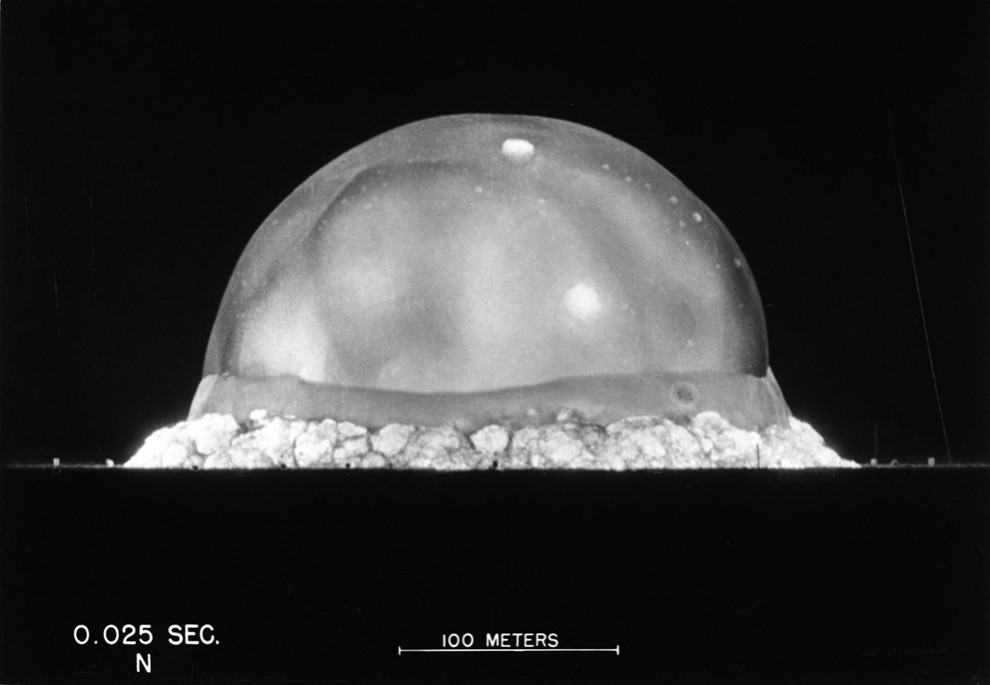
5. The growing fireball and the blast wave of the Trinity explosion in 0.025 seconds after the explosion on July 16, 1945. (U.S. Department of Defense)
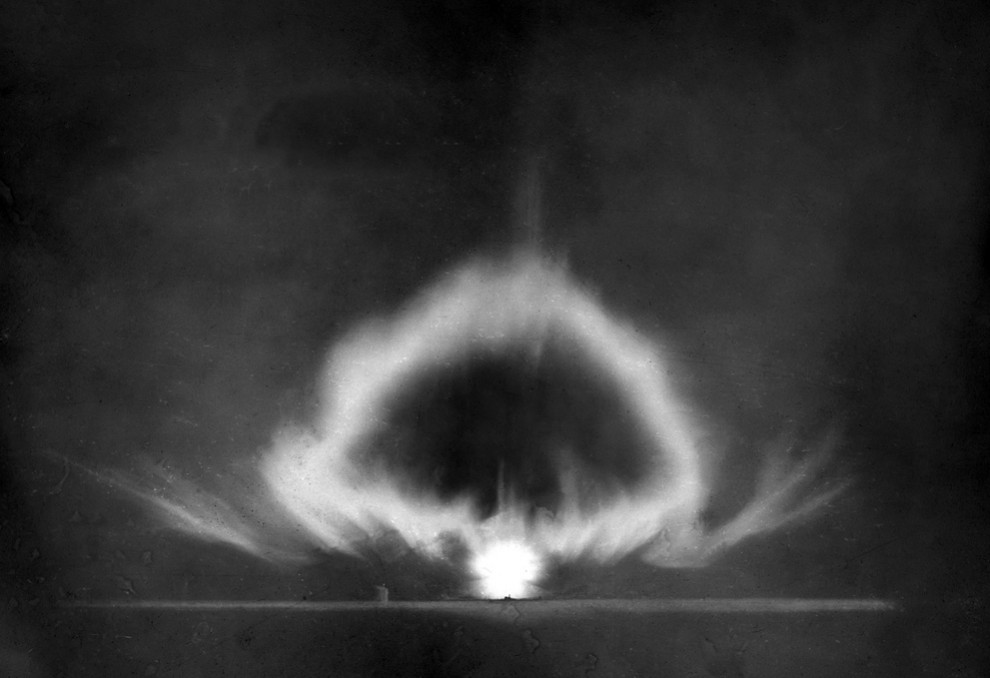
6. Photo of the Trinity blast with a long exposure a few seconds after detonation. (U.S. Department of Defense)
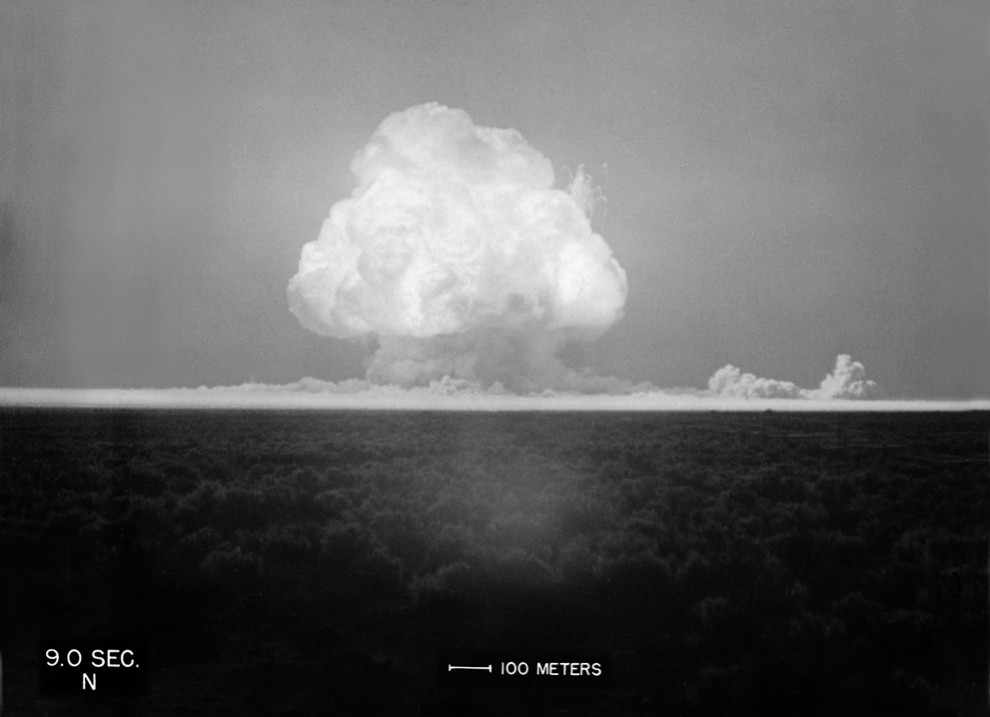
7. Fireball "fungus" of the first atomic explosion in the world. (U.S. Department of Defense)
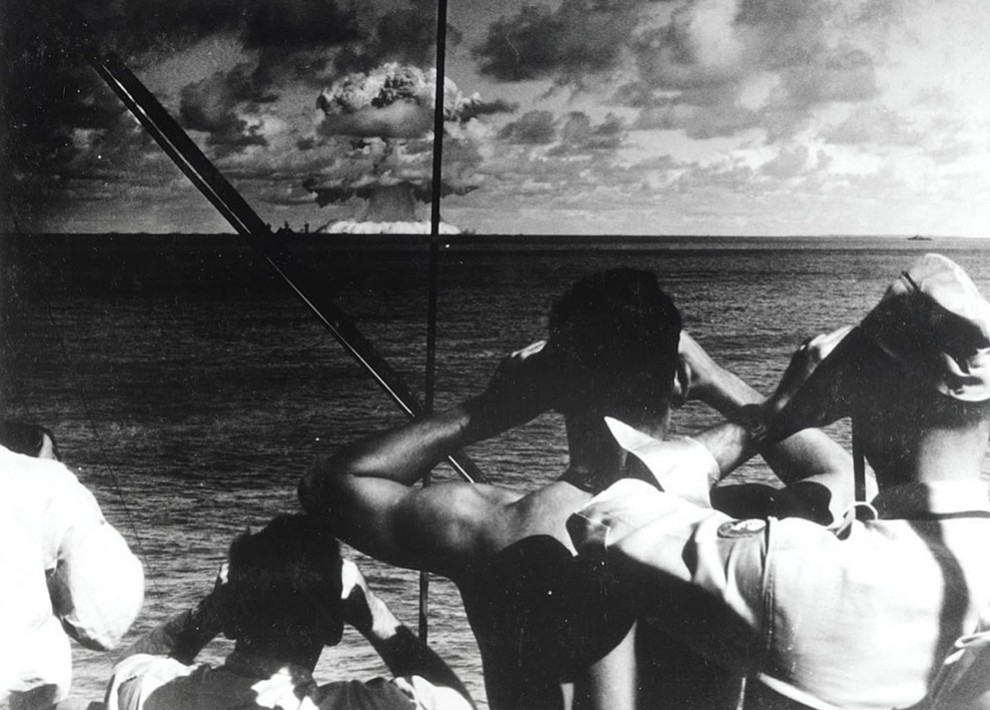
8. The US military is watching the explosion during Operation Crossroads on the Bikini Atoll on July 25, 1946. It was the fifth atomic explosion after the first two test and two atomic bombs dropped on Hiroshima and Nagasaki. (U.S. Department of Defense)
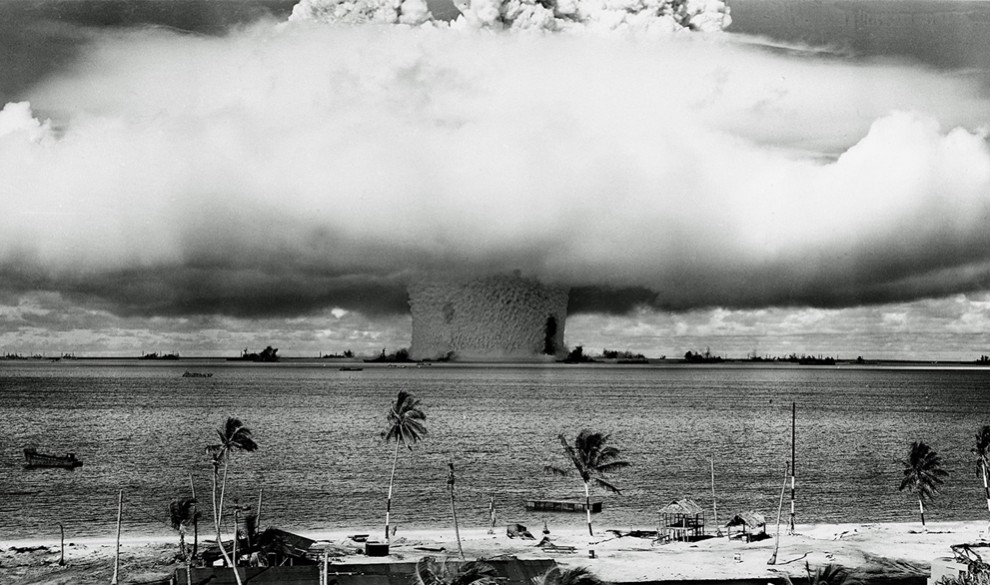
9. A nuclear mushroom and spray pillar at sea during a test of a nuclear bomb on the Bikini Atoll in the Pacific Ocean. It was the first underwater atomic explosion test. After the explosion, several former warships were stranded. (AP Photo)

10. Huge nuclear mushroom after the bombing of the Bikini Atoll on July 25, 1946. Dark dots in the foreground are ships placed specifically in the path of the blast wave to check what it will do to them. (AP Photo)
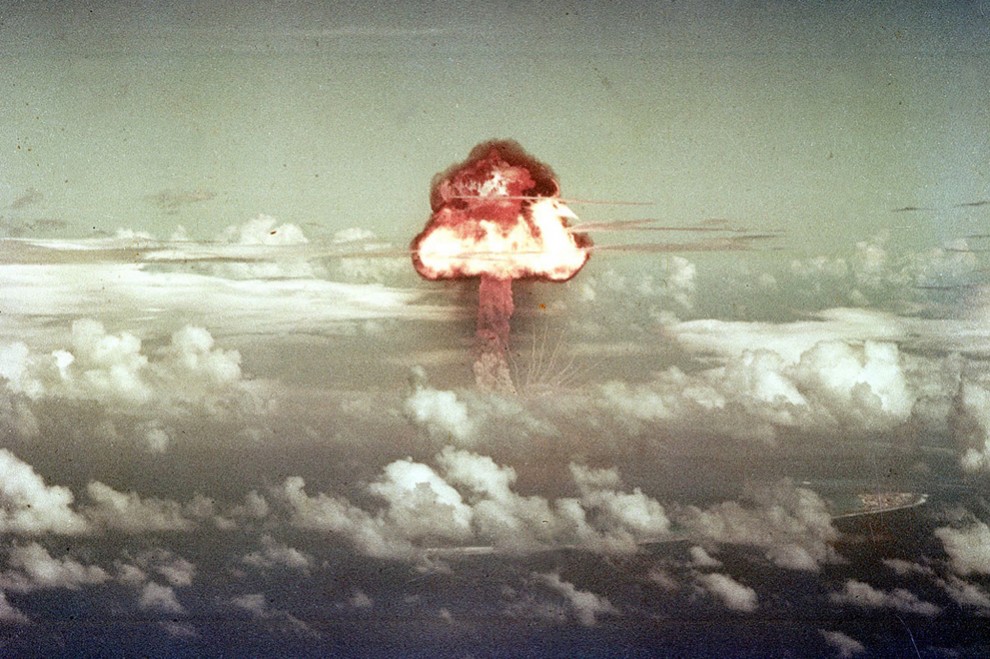
11. On November 16, 1952, the B-36H bomber dropped an atomic bomb on the northern part of the island of Runit on Enyvetok Atoll. The result was an explosion with a capacity of 500 kt and a diameter of 450 meters. (U.S. Department of Defense)
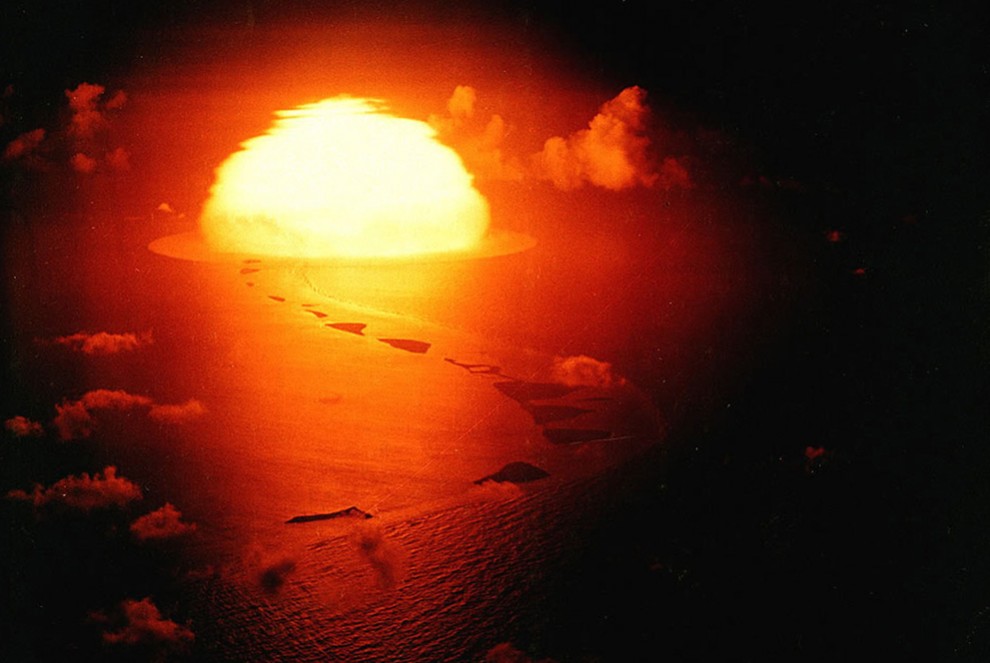
12. Operation Greenhouse took place in the spring of 1951. It consisted of four explosions in the Pacific nuclear test site in the Pacific. This is a photo of the third test, codenamed "George", held on May 9, 1951. It was the first explosion in which deuterium and tritium were burned. Power - 225 kilotons. (U.S. Department of Defense)
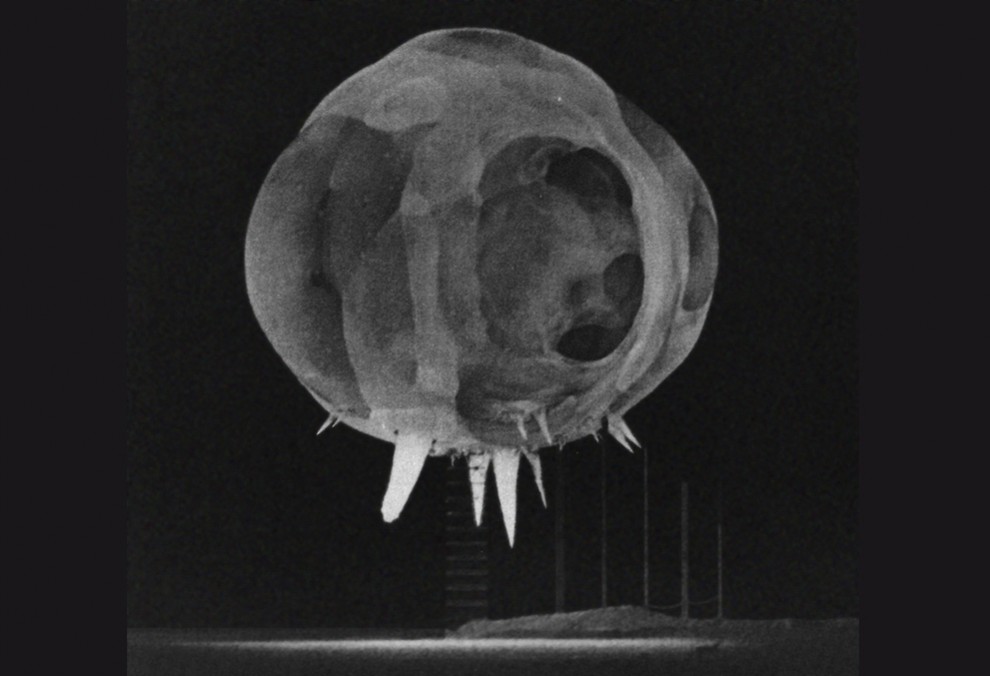
13. “Rope tricks” of a nuclear explosion, captured in less than one millisecond after the explosion. During Operation Tumbler-Snapper in 1952, this nuclear device was suspended 90 meters above the Nevada desert on mooring ropes. As the plasma spread, the radiated energy overheated and evaporated the cables over the fireball, as a result of which these “spits” came out. (U.S. Department of Defense)

14. During Operation Abshot-Nothol, a group of dummies was put in the canteen of a house to experience the effect of a nuclear explosion on houses and people, on March 15, 1953. (AP Photo / Dick Strobel)
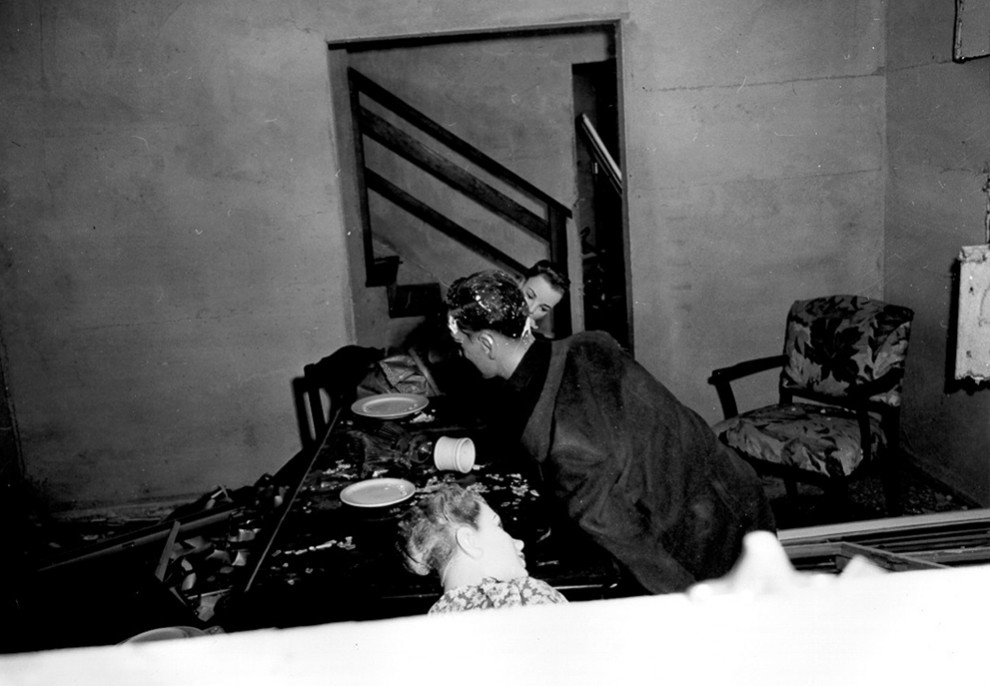
15. This is what happened to them after the nuclear explosion. (U.S. Department of Defense)
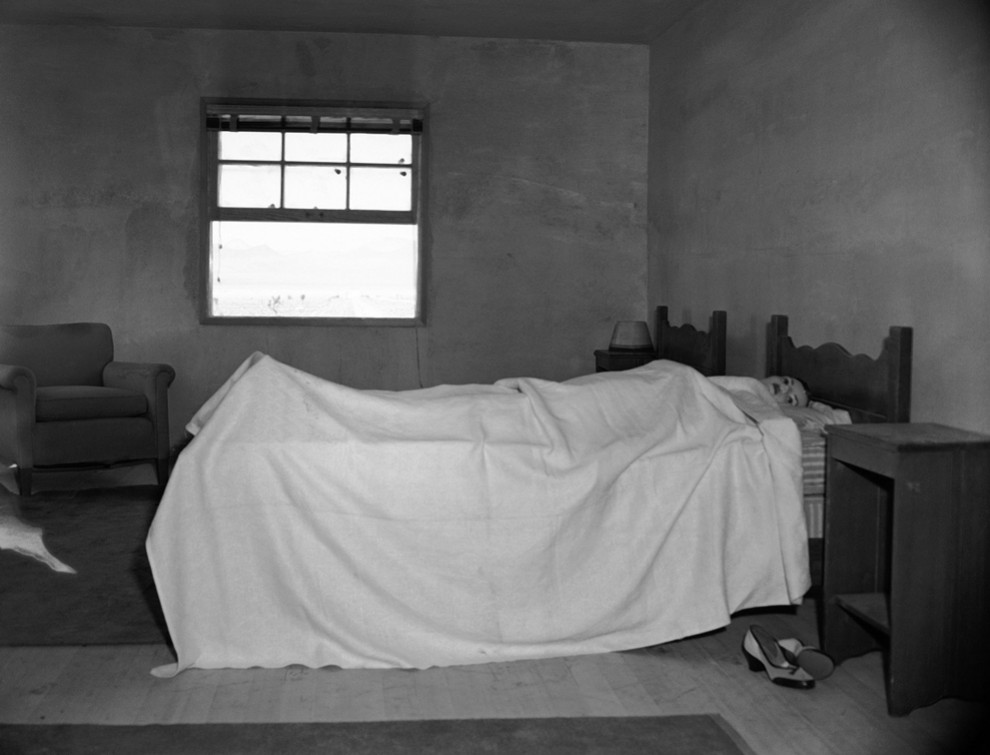
16. In the same house number two, on the second floor on the bed was another mannequin. In the window of the house is visible 90-meter steel tower, which will soon explode a nuclear bomb. The purpose of a test explosion is to show people what will happen if a nuclear explosion occurs in a US city. (AP Photo / Dick Strobel)
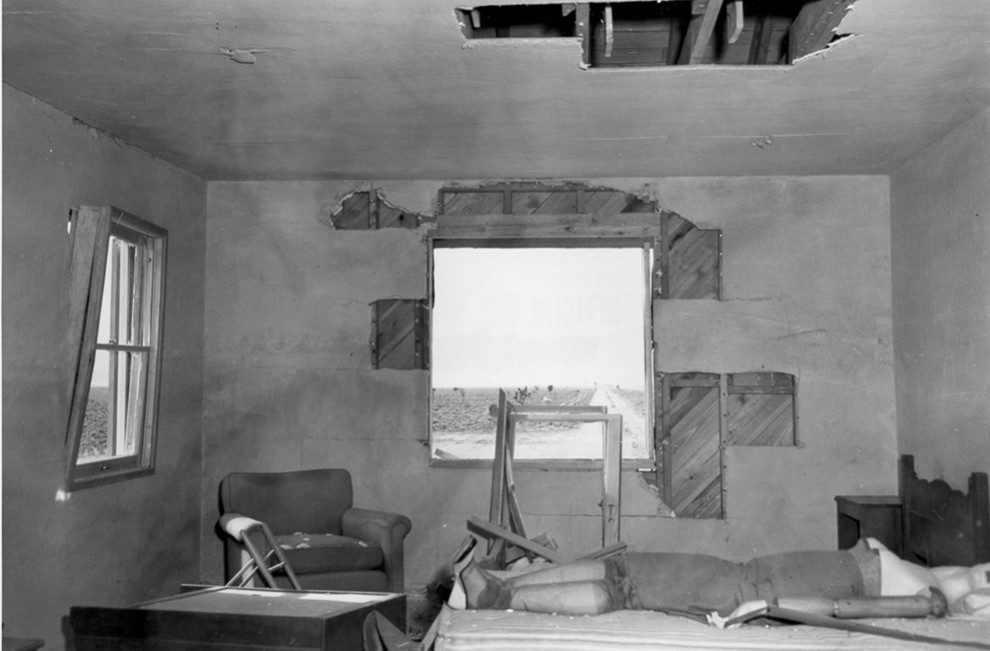
17. Damaged bedroom, windows and disappeared to hell where the blankets after the test explosion of the atomic bomb on March 17, 1953. (U.S. Department of Defense)

18. Mannequins, representing a typical American family, in the living room of the test house number 2 on the territory of the nuclear ground Nevada. (AP Photo)

19. The same "family" after the explosion. Someone scattered throughout the living room, someone just disappeared. (U.S. Department of Defense)
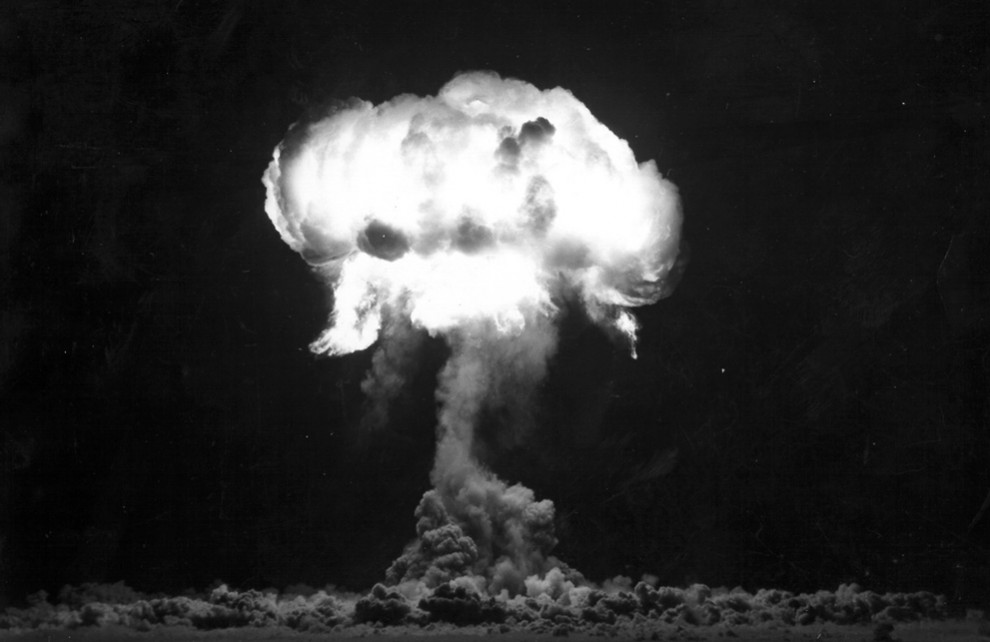
20. During Operation Plumb on the Nevada nuclear test site on August 30, 1957, a projectile detonated from a ball in the Yukka Flat desert at a height of 228 meters. (National Nuclear Security Administration / Nevada Site Office)

21. The test explosion of a hydrogen bomb during Operation Redwing on the Bikini Atoll on May 20, 1956. (AP Photo)
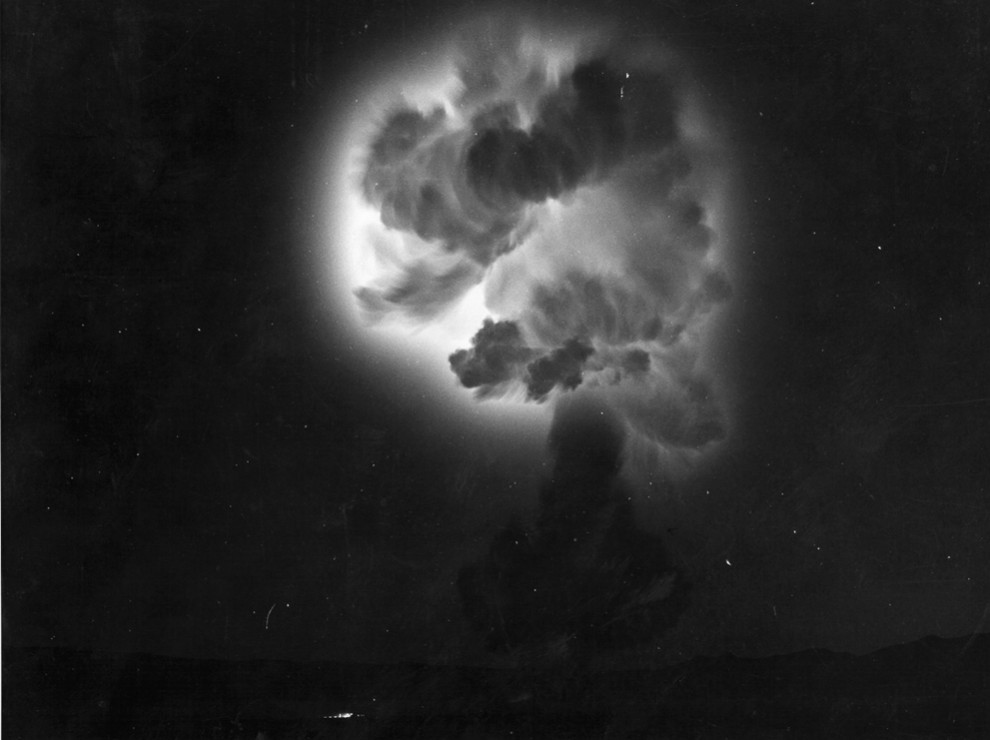
22. Ionization radiance around the cooling fireball in the Yucca desert at 4:30 am July 15, 1957. (National Nuclear Security Administration / Nevada Site Office)
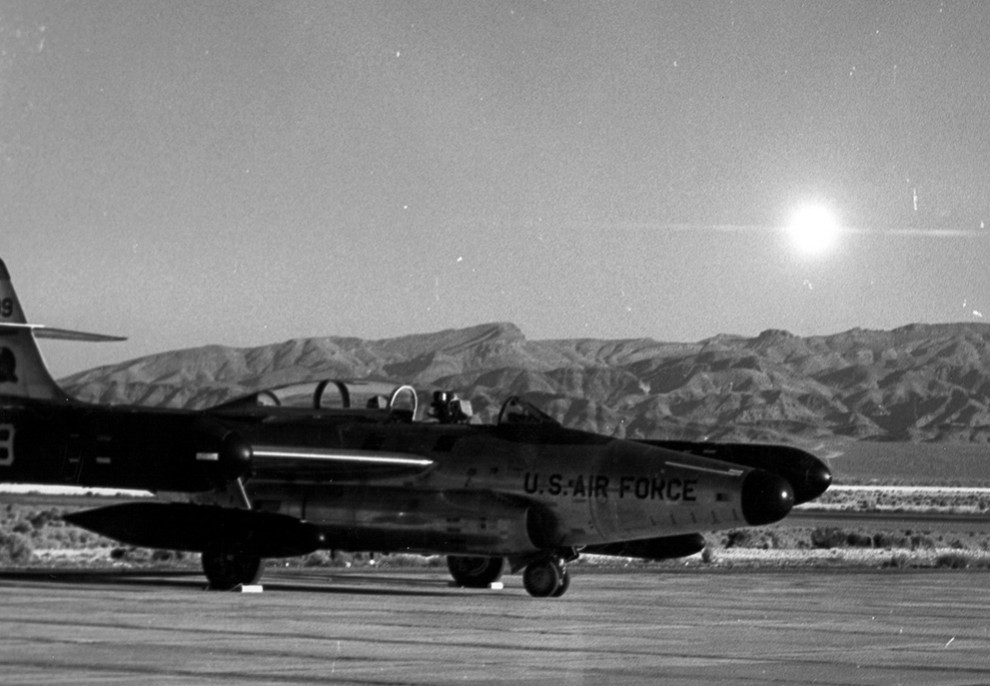
23. An outbreak of an exploded nuclear warhead of an air-to-air missile at 7:30 am on July 19, 1957 at the Indian Springs airbase, 48 km from the site of the explosion. In the foreground is a Scorpion aircraft of the same type. (National Nuclear Security Administration / Nevada Site Office)
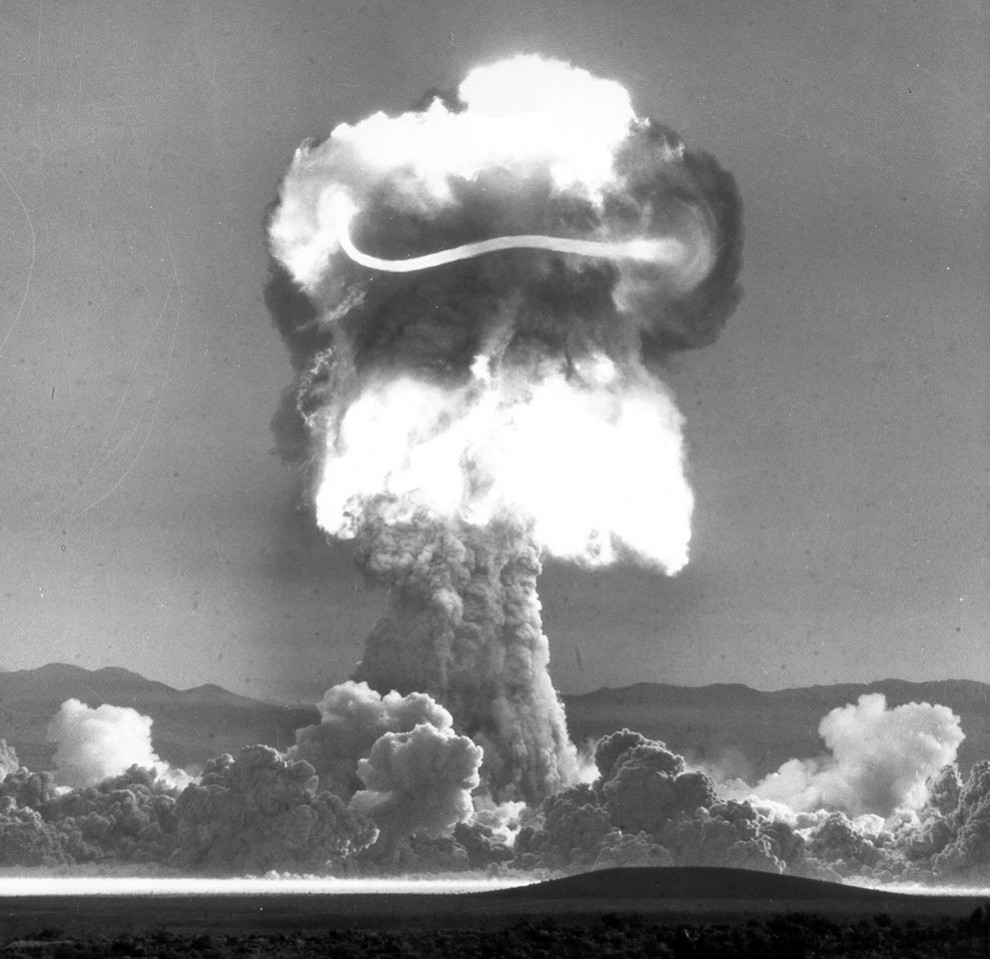
24. The fireball of the Priscilla projectile on June 24, 1957 during the “Plummet” series of operations. (National Nuclear Security Administration / Nevada Site Office)
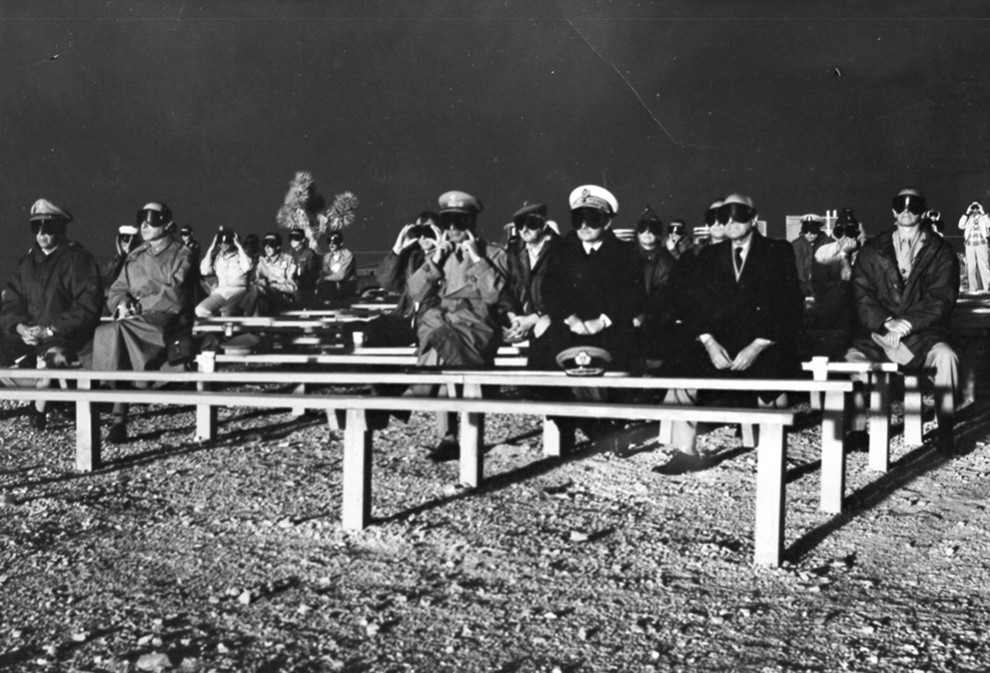
25. Representatives of NATO are watching the explosion during Operation Boltzmann on May 28, 1957. (National Nuclear Security Administration / Nevada Site Office)
![]()
26. The tail part of the airship of the US Navy after the test of Yao in Nevada on August 7, 1957. The airship flew in free flight, more than 8 km from the epicenter of the explosion, when it was overtaken by a blast wave. There was no one in the airship. (National Nuclear Security Administration / Nevada Site Office)
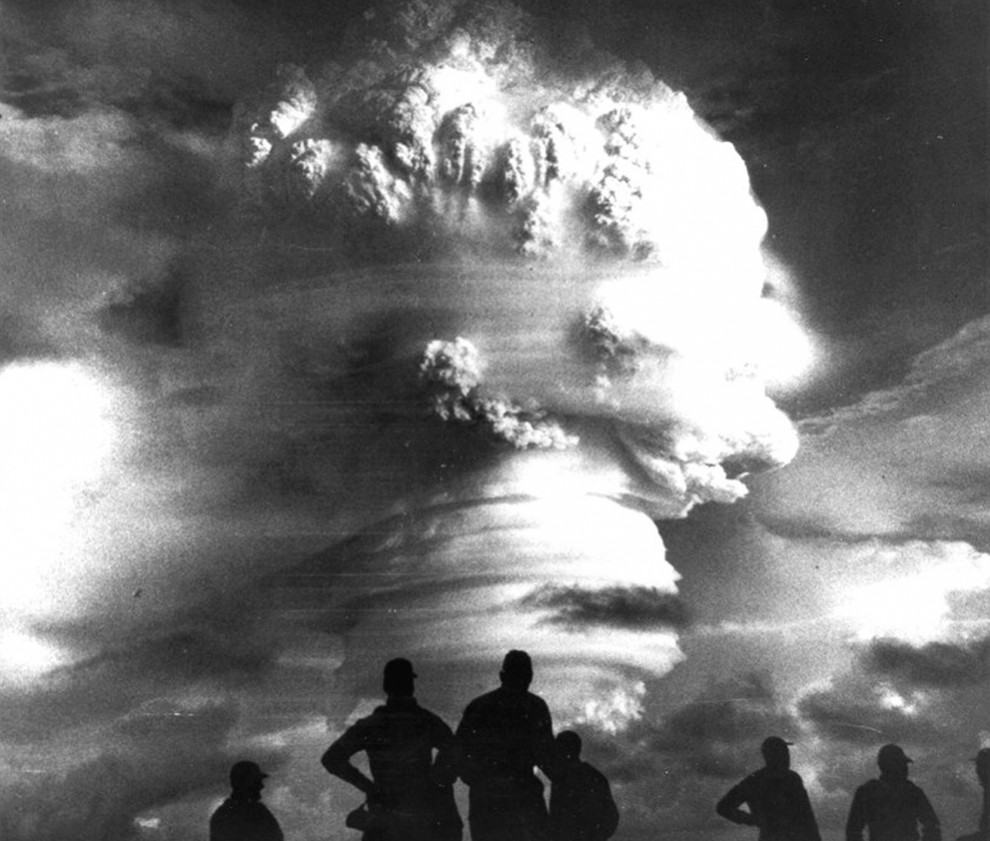
27. Observers during the operation of Hardtack I - a thermonuclear bomb explosion in 1958. (National Nuclear Security Administration / Nevada Site Office)
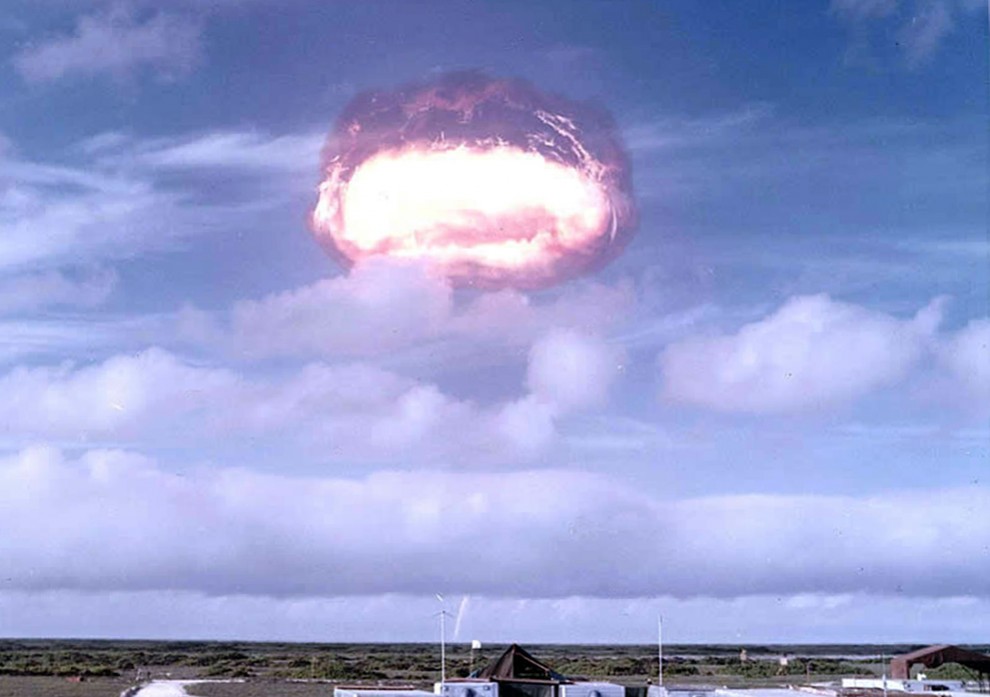
28. Arkansas tests - part of Operation Dominic - a series of more than a hundred explosions in Nevada and the Pacific in 1962. (U.S. Department of Defense)
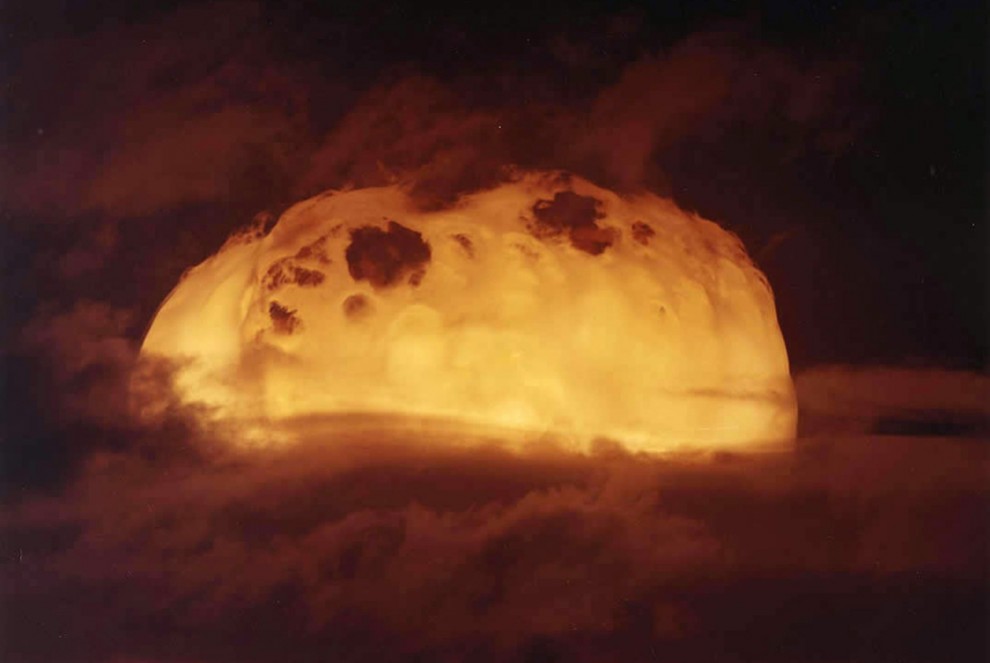
29. Fireball of the Aztec Test Test, which is part of Operation Dominic in Nevada. (U.S. Department of Defense)

30. Part of the 'Fishbowl Bluegill' series of high-altitude nuclear tests - an explosion with a capacity of 400 kt in the atmosphere, at an altitude of 48 km above the Pacific Ocean. View from above. October 1962. (U.S. Department of Defense)
3121,990 × 633 Tests of nuclear weapons
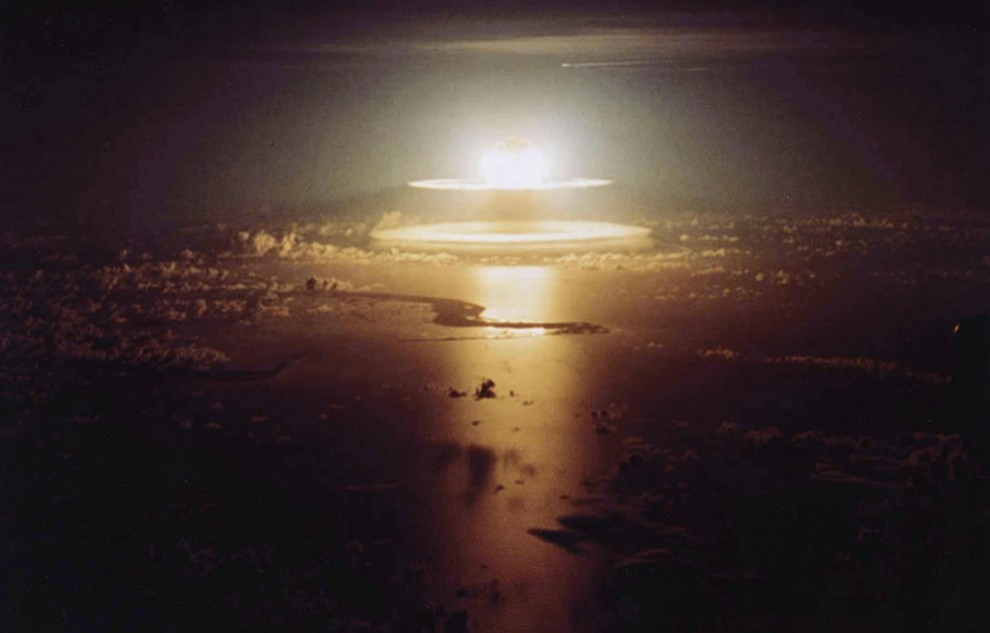
31. Rings around the mushroom cloud during the “Yeso” test project in 1962. (U.S. Department of Defense)

32. Crater Sedan was formed after the explosion of 100 kilotons of explosives at a depth of 193 meters under the loose sediments of the desert in Nevada on July 6, 1962. The crater turned out to be 97 meters deep and 390 meters in diameter. (National Nuclear Security Administration / Nevada Site Office)

33. Photo of a nuclear explosion of the French government on the atoll of Mururoa in 1971. (AP Photo)
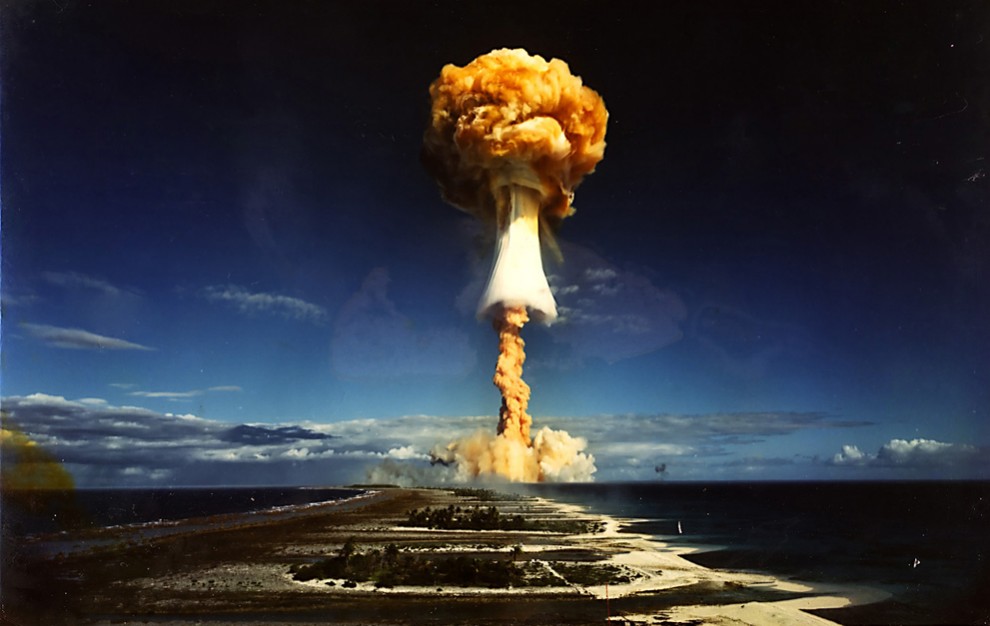
34. The same nuclear explosion on the atoll of Mururoa. (Pierre J. / CC BY NC SA)

35. The “Surviving City” was built at 2,286 meters from the epicenter of a nuclear explosion with a capacity of 29 kilotons. The house has remained virtually intact. The "surviving city" consisted of houses, office buildings, shelters, sources of electricity, communications, radio stations and "residential" vans. The test, codenamed "Apple II", was held on May 5, 1955. (U.S. Department of Defense)
Source: bigpicture.ru
Nuclear explosions in photos
Since 1945, around 2,000 nuclear tests have been carried out in the world and 2 nuclear attacks have been committed. The undoubted leader in the destructive release of atomic energy is the United States.
The attention of photographers did not go around the uncontrollable and terrifying process of an atomic explosion. We present to your attention a selection of photos from the book by Peter Quran "How to make a photo of the atomic bomb"
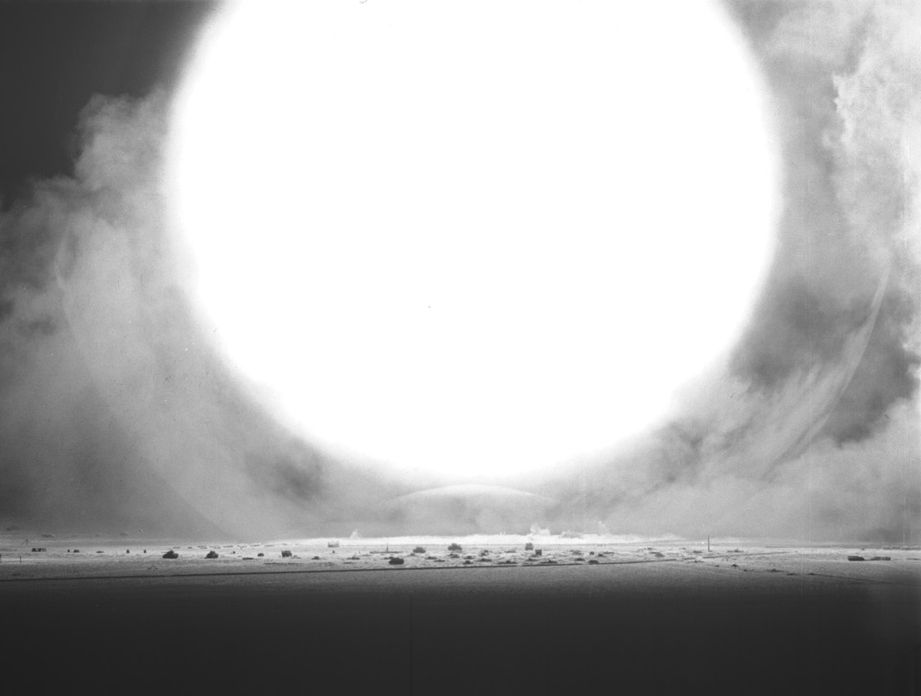
1. This is how the process of releasing a huge amount of radiant and thermal energy in an atomic explosion in the air over the desert looks like. Here you can still see the military equipment, which in a moment will be destroyed by a shock wave, captured in the form of a crown, surrounded the epicenter of the explosion. It is seen as a shock wave reflected from the earth's surface and is about to merge with the fireball.

2. At the request of the Department of Defense and the Nuclear Energy Commission, thousands of photographs of nuclear explosions were taken by specialists from the Lookout Mountain Center (California). Photographing an atomic explosion is extremely dangerous, so no specials. costume is indispensable.

3. The tests of nuclear missiles in the Pacific from 1946 to 1962 not only showed their power in the fight against the navy, but also became the source of nuclear pollution of ocean waters.

4. Photos of the initial stage of a nuclear explosion, when its speed of propagation is close to the speed of light, can be considered a great success. The image was made with a camera with an incredibly fast shutter, which is located 3.5 km from the epicenter of the explosion.
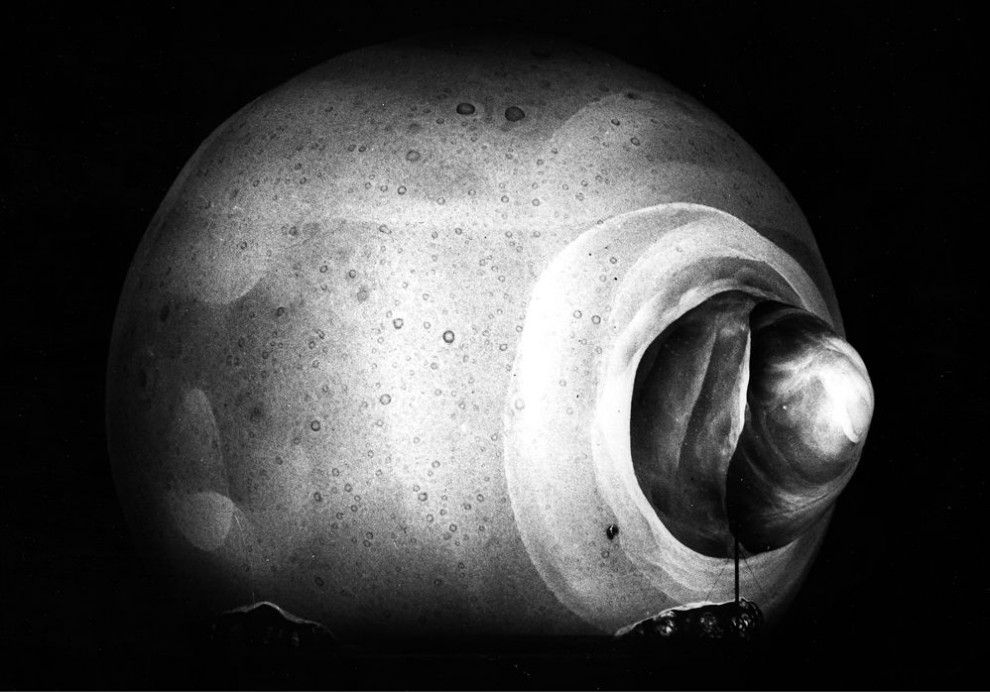
5. The glowing sphere of a nuclear explosion absorbs a tower with ammunition placed in it.
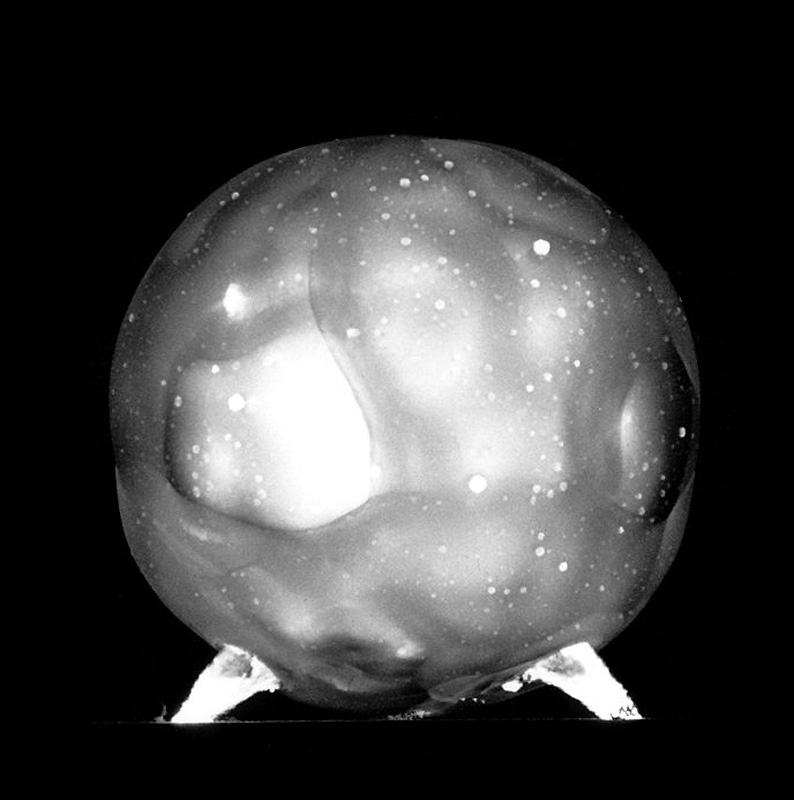
6. Another photo of the early stage of an atomic explosion made by a special camera located a few kilometers from the epicenter.
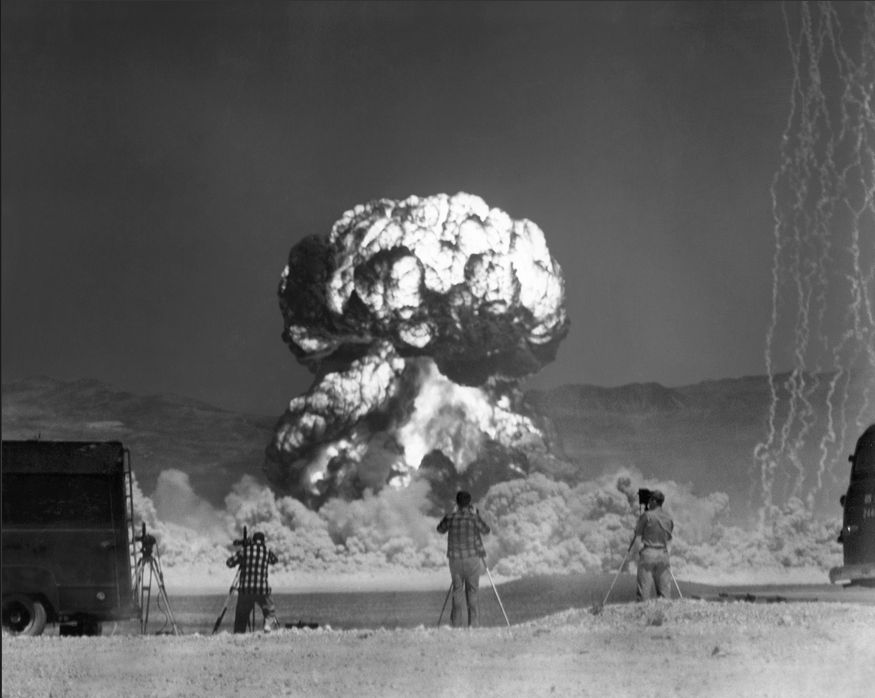
7. For taking good pictures, entire teams of photographers often work on the test sites. In the photo: a test nuclear explosion in the Nevada desert. To the right are rocket plumes, with the help of which scientists determine the characteristics of the shock wave.
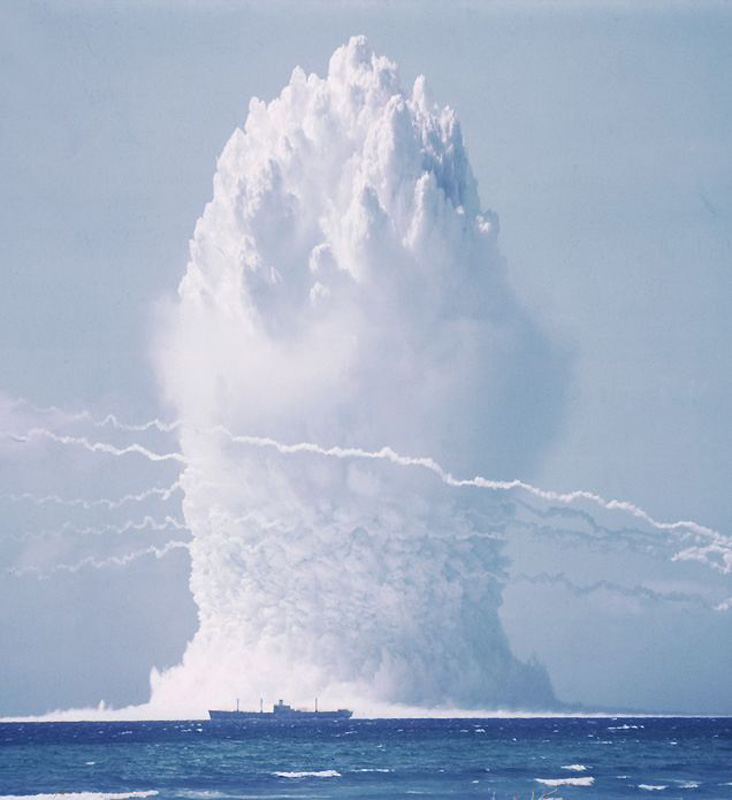
8. The explosion of the atomic bomb, whose power is about half the power of the Malysh bomb dropped on the Japanese city of Hiroshima on August 6, 1945, lifted thousands of tons of water into the air and caused a whole group of destructive tsunamis.
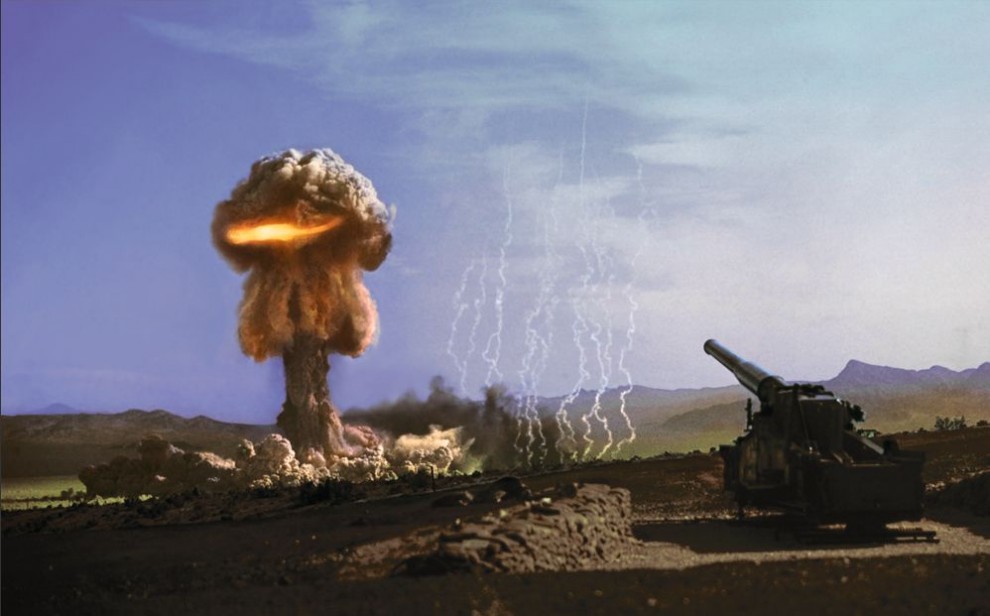
9. At a test site in the Nevada desert, photographers of the Lookout Mountain Center in 1953 took a photo of an unusual phenomenon (ring of fire in a mushroom mushroom after a nuclear cannon explosion), the nature of which has long occupied the minds of scientists.

10. Specialists of the Lookout Mountain Center take a photo of the aircraft, which should participate in nuclear tests (1957).

11. The huge aircraft was located 8 km from the epicenter of a nuclear explosion, but it did not manage to escape from the powerful blast wave.
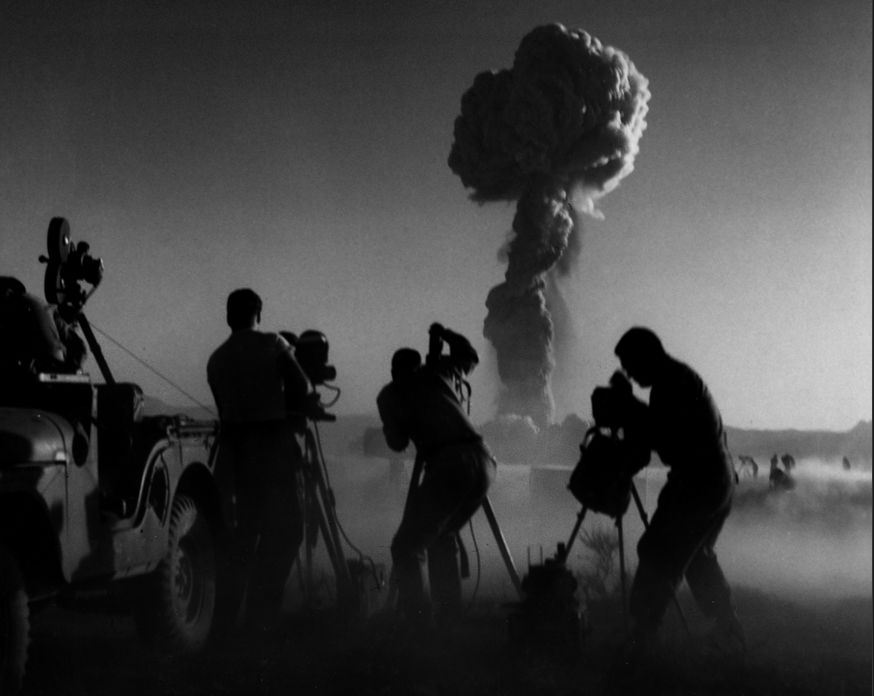
12. Photographers from Lookout Mountain are standing to the waist in the dust raised by the shock wave after a nuclear explosion (1953 photo).
![]()
13. During the chain reaction, there is a sharp release of a huge amount of energy, which causes an instantaneous increase in the temperature of the explosive substance, reaching millions of degrees and transmitted to the environment. In the photo - a school bus, which will take part in nuclear testing.

14. After the explosion of the test atomic bomb, the paint on the bus foams.
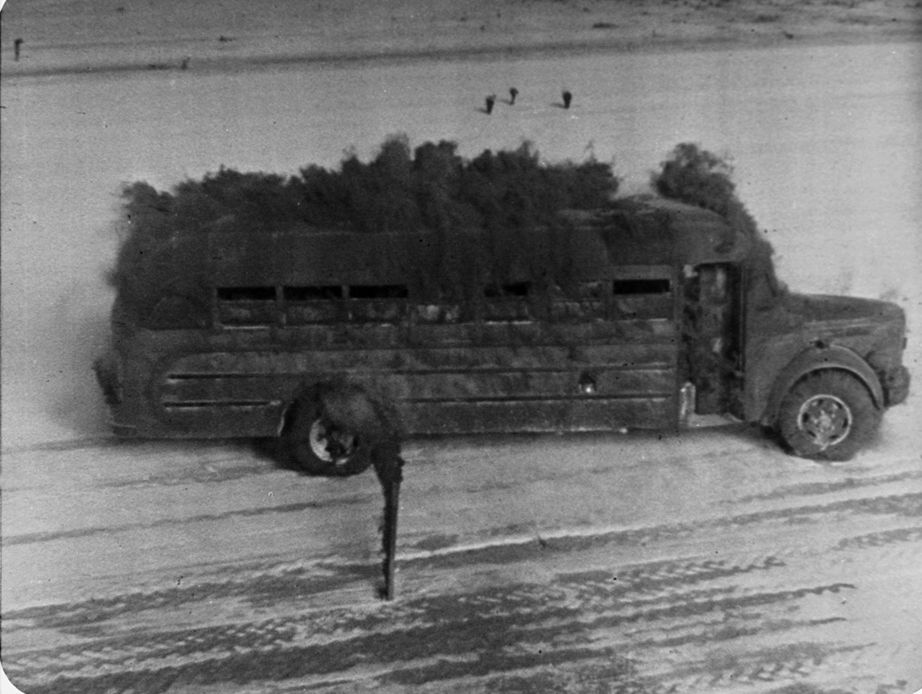
15. And after moments the paint begins to evaporate from the metal body of the bus.
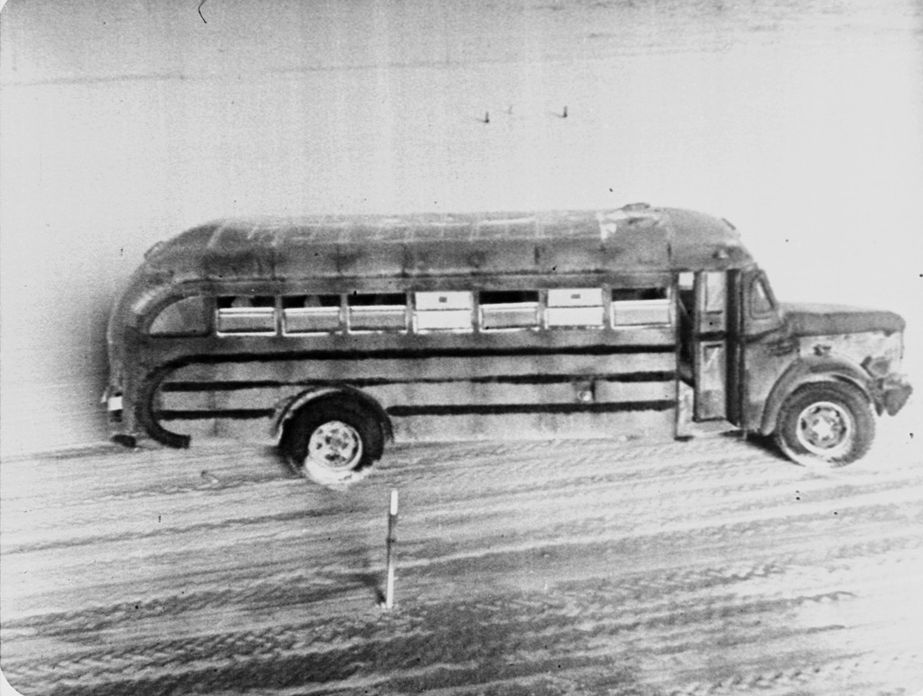
16. But the bus is saved from complete combustion by a shock wave, which extinguishes the fire with lightning speed.
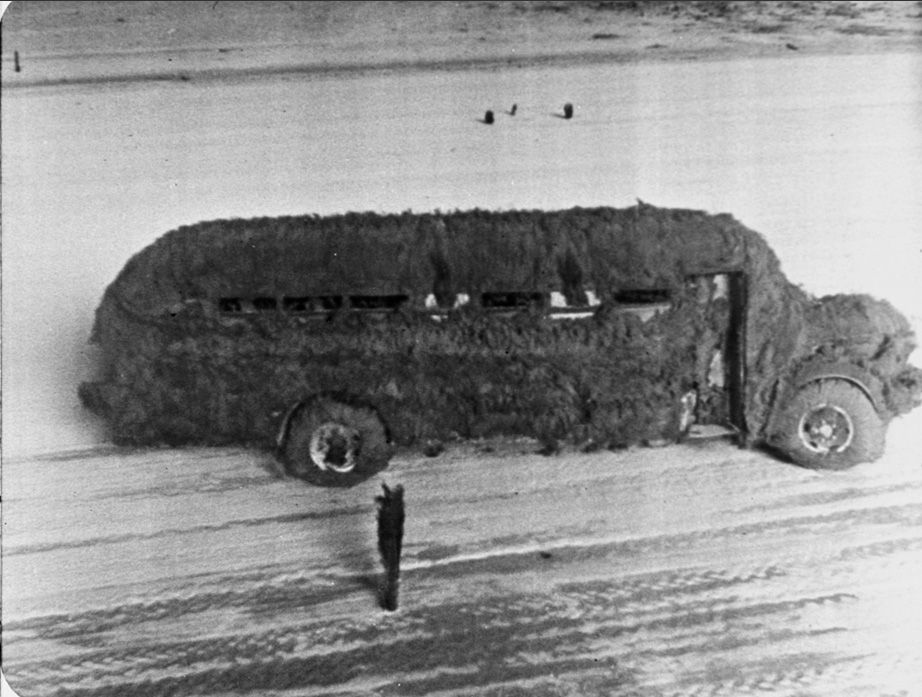
17. During the next explosion, all components of the school bus that can burn, burn down ...
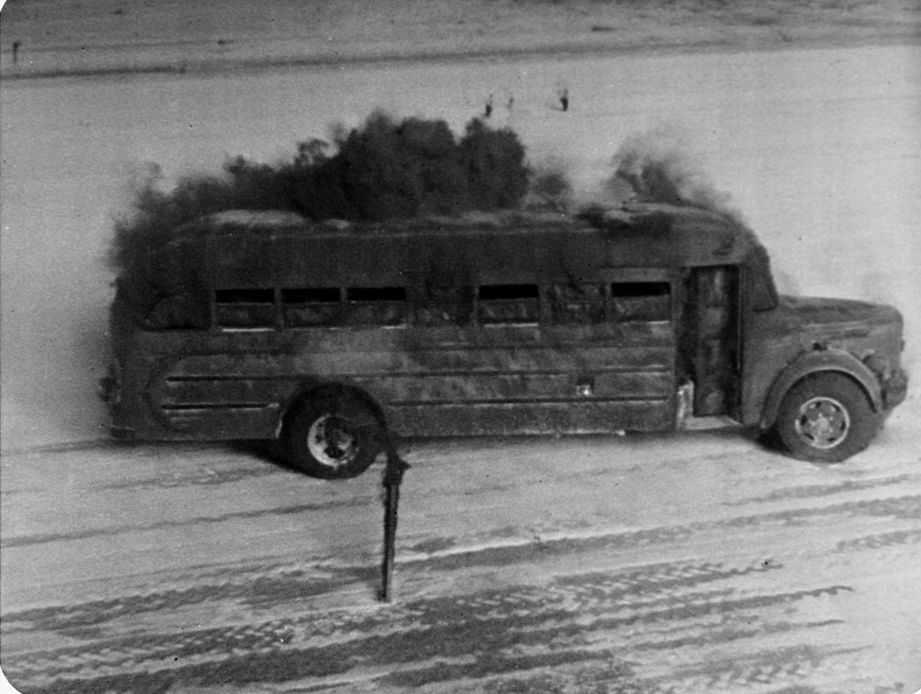
18. ... and evaporate, leaving only the skeleton of the vehicle.
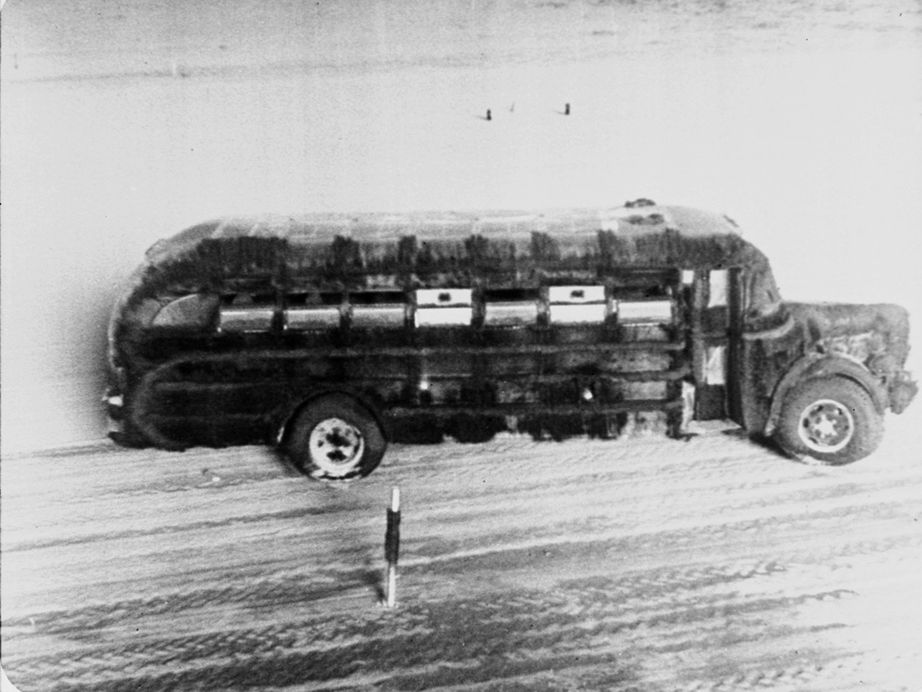
19. In addition to the enormous thermal radiation from a nuclear explosion, powerful electromagnetic radiation is emitted in a wide spectrum, causing radioactive contamination of the area and everything that is on it.
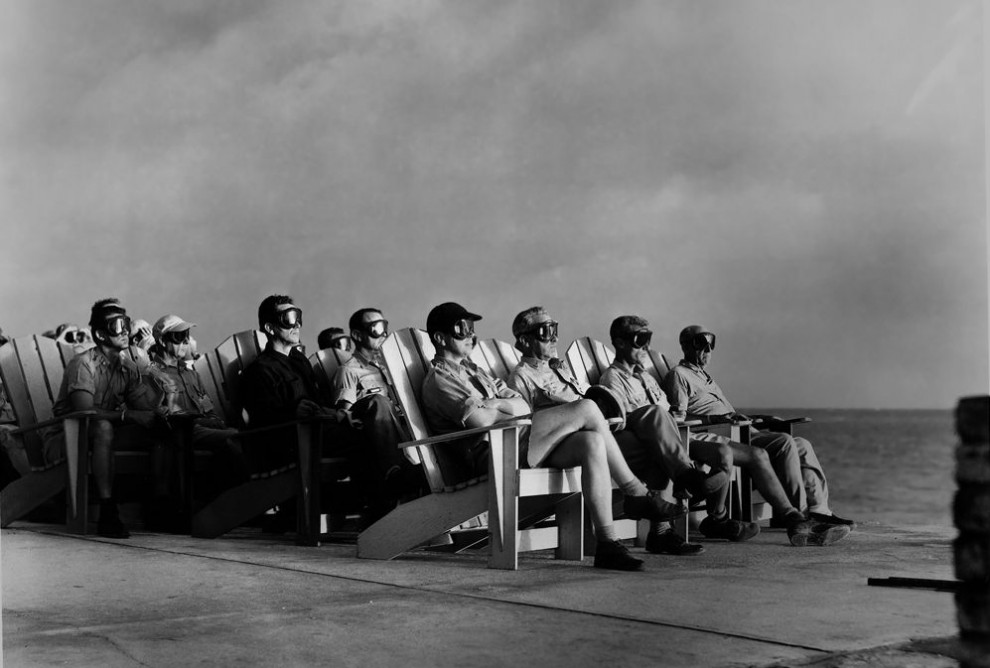
20. Despite the deadly radiation, in 1951 nuclear tests in Nevada were invited to observe various important people, nuclear tourism was popular (people tried to get to the area where the mushroom cloud was visible), and during the Desert Rock exercise, the command ordered infantrymen run right under the deadly mushroom.
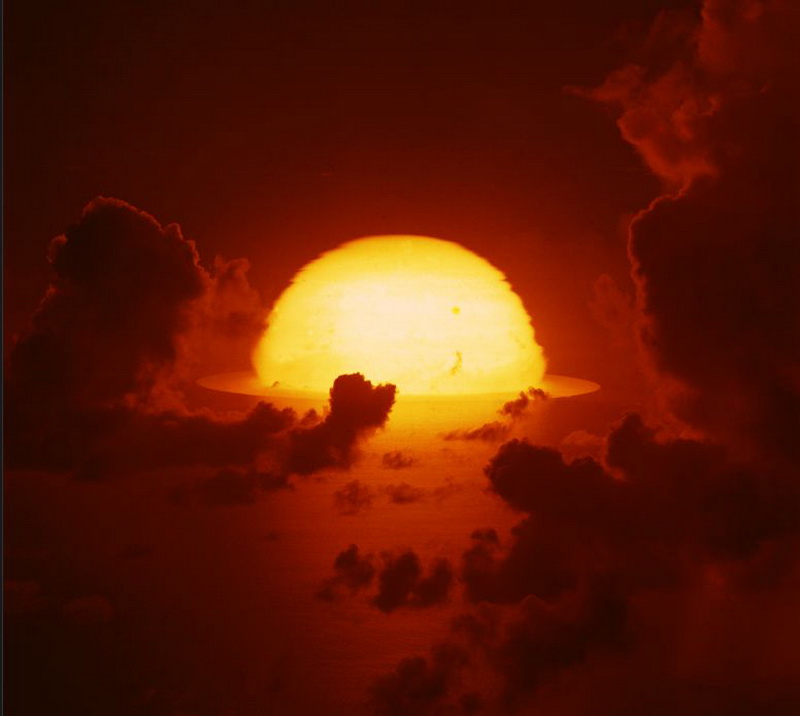
21. A fireball captured on a film, similar to the sun going beyond the horizon, is the result of a hydrogen bomb explosion in the Pacific Ocean (1956).
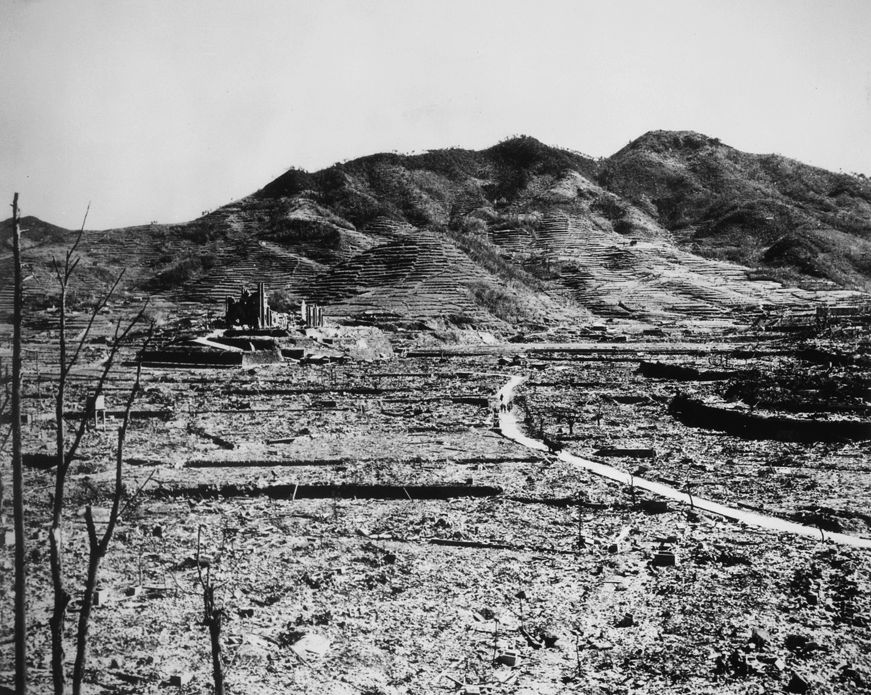
22. Photo of the ruins of the Catholic Church on a deserted hill in the Japanese city of Nagasaki. Such was the landscape of the city after the explosion of the atomic bomb dropped by the USA at the end of the Second World War.
Judging by the publications in the press, especially the Western, uranium and plutonium in Russia rolls around at every landfill. I do not know, he did not see, but maybe where he was lying around. But the question is - can a certain terrorist, having a kilogram ... well, or 100 kilograms of uranium, build something explosive from it?
So how does an atomic bomb work? We recall the school course of physics. An explosion is the release of a large amount of energy in a short period of time. Where does the energy come from? Energy arises from the decay of the nucleus of an atom. The atoms of uranium or plutonium are unstable, and slowly they tend to fall into atoms of the lighter elements, and extra neutrons fly out and some energy is released. Well, remember? There is also a half-life - a sort of statistical value, a period of time in which about half of the atoms of a certain mass "will collapse". That is, the uranium lying in the ground gradually ceases to be such, heating the surrounding space. The disintegration process can provoke a neutron that flies into the atom, which has taken off from the recently collapsed atom. But a neutron can get into an atom, and maybe fly past. The logical conclusion is that the atoms would fall apart more often, it is necessary that there are more of them around, that is, that the density of the substance is large at the moment when an explosion is to be organized. Remember the concept of "critical mass"? This is the amount of substance when spontaneously emitted neutrons are enough to cause a chain reaction. That is, there will be more "hits" at each moment in time than atoms of "destruction".
So, the scheme appears. Take a few pieces of Uranus of subcritical mass and combine them into one block of supercritical mass. And then there will be an explosion.
Fortunately, everything is not so simple, the question is how exactly the connection occurs. If two subcritical pieces are brought together for some distance, then they will begin to warm up due to the exchange with each other of the emitted neutrons. The decay reaction from this is amplified and there is an increasing release of energy. Let's take it even harder - red-hot. Then white. Then melt. The melt, approaching the edges, will begin to heat up further and evaporate, and no heat removal or cooling can prevent melting and evaporation, the energy reserves in Uranus are too large.
Therefore, as the pieces do not bring together using household methods, they will melt and evaporate any device performing this convergence before they unite, and evaporate themselves, flying apart, expanding, moving away from each other and then only cooled down, because they will end up at an increased mutual distance. . It is possible to blind the pieces into one supercritical one only by developing such enormous rates of convergence that the increase in the neutron flux density will not keep pace with the approach of the pieces. This is achieved at convergence speeds of about 2.5 km per second. That's when they have time to stick with each other before they warm up from the energy release. And then the subsequent energy release will be so peak that a nuclear explosion with a mushroom will occur. It is impossible to overclock with gunpowder to such speeds - the size of the bomb and the ways of dispersal are small. Therefore, they are dispersed by explosives, combining "slow" and "fast" explosives, for immediately "fast" explosives will cause the destruction of a piece by a shock wave. But in the end they get the most important thing - they ensure the speed of the system being transferred to the supercritical state before it collapses in a thermal way due to the growing heat release when approaching. Such a scheme is called “cannon”, because subcritical pieces are “fired” towards each other, managing to unite in one supercritical piece and after this peak release the power of the atomic explosion.
To carry out such a process in practice is extremely difficult - it requires the correct selection and a very accurate match of thousands of parameters. It is not an explosive that explodes in many cases. Simply, the detonators and charges in the bomb will be triggered, and the practical power released will not be observed, it will be extremely low with a very narrow active explosion zone. Microsecond accuracy of a large number of charges is required. The stability of the atomic substance is necessary. Remember, besides the initiated decay reaction, there is also a spontaneous, probabilistic process. That is, the collected bomb gradually changes its properties over time. That is why they distinguish between weapons-grade atomic matter and one that is not suitable for creating a bomb. Therefore, they do not make atomic bombs from reactor plutonium, because such a bomb would be too unstable and dangerous for the manufacturer rather than for a potential enemy. The process of separating atomic substances into isotopes is in itself extremely complicated and expensive, and can only be carried out in serious nuclear centers. And it pleases.



